Paul van Yperen's Blog, page 389
March 7, 2015
Peter Garden
German actor, singer and TV-show presenter Peter Garden (1924) was the ‘beautiful man’ in films of the Wirtschaftswunder era. Like his Hollywood equivalent Rock Hudson, he often posed shirtless for beefcake photos. He was at the height of his popularity in the late 1960s, when he presented two TV shows. But 'Black Peter' had a dark past which abruptly finished his showbiz career.
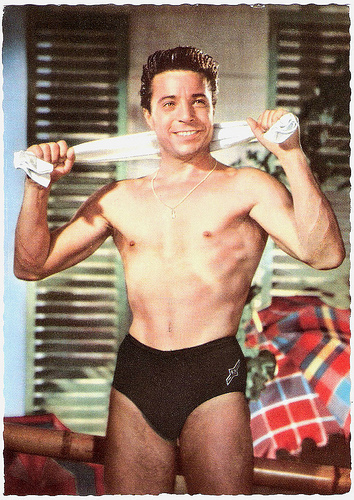
German postcard by Ufa (Universum-Film Aktiengesellschaft), Berlin-Tempelhof, no. CK-87. Retail price: 30 Pfg. Photo: Arthur Grimm / Ufa.
Women's Hero
Peter Garden was born as Karlheinz Rothmayer in München (Munich), Germany, in 1924. He was the son of the singer Karl Rothmayer.
After his military service he attended the Musikhochschule Salzburg (the college of music in Salzburg) and in 1947, he went to the Volksoper München (the People's Opera Munich).
In the early 1950s he worked at the Bayerischen Staatsoperette (Bavarian state operetta). He also made his film debut at that time. After two years at the Stadttheater Bern (the Municipal theatre in Bern) he finished his stage career and returned to Munich to devote himself intensely to his film career.
He appeared in such comedies as Ein Herz bleibt allein/My Leopold (Géza van Bolváry, 1955), Ball im Savoy/Ball at the Savoy (Paul Martin, 1955) and Der Falsche Adam/The False Adam (Géza von Cziffra, 1955).
He posed shirtless for beefcake photos, and was groomed to become a romantic leading man like Rock Hudson in Hollywood. Garden grew to bigger roles in light entertainment films like Dany, bitte Schreiben Sie/Dany, Please Write (Eduard von Borsody, 1956) with Sonja Ziemann , Schön ist die Welt/Fair Is the World (Géza von Bolvary, 1957), and Egon, der Frauenheld/Egon, the Women's Hero (Hans Albin, 1957).
In 1959, he divorced his first wife, actress Christiane Jansen.
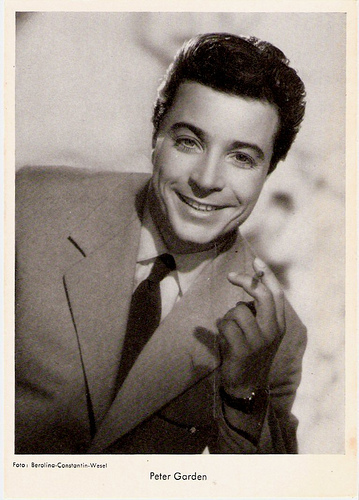
Dutch postcard. Photo: Berolina-Constantin-Wesel.
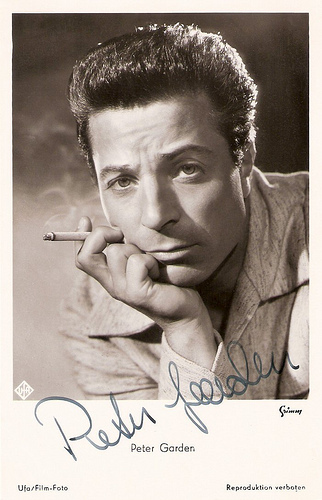
German postcard by Ufa-Film/foto, Berlin/Tempelhof, no. 3694. Retail price: 25 Pfg. Photo: Arthur Grimm.
Krimis
In the early 1960s the German cinema declined, and there were no more film roles for Peter Garden. He kept working for stage and TV.
As a singer he appeared in several TV-operettas like Viktoria und ihr Husar/Viktoria and her Hussar (1965) at the side of such stars as Johannes Heesters and Rudolf Schock .
He played in Krimis (the typical German crime series) like Das Kriminalmuseum (1963-1964), and in the musical Polenblut/Polish Blood (Wolfgang Liebeneiner, 1966).
He often performed together with his second wife, Margit Nünke, Miss Germany 1955 and Miss Europe 1956.
In the late 1960s, he was seen in dubious film comedies like Pudelnackt in Oberbayern/Completely Naked in Upper Bavaria (Hans Albin, Hans Billian, 1969) and Hugo der Weiberschreck/Hugo, the Woman Chaser (Hans Albin, 1969).
He fared better on television. As a TV host he had his own shows like Die Peter Garden Party (1969-1970) and Schwarzer Peter/Black Peter (1970).
He also worked as a singer and recorded the lp Herzlichst Ihr Peter Garden. He sang a duet with Margit Nünke, Jede Woche, die hat 7 Tage (Every Week Has Seven Days).
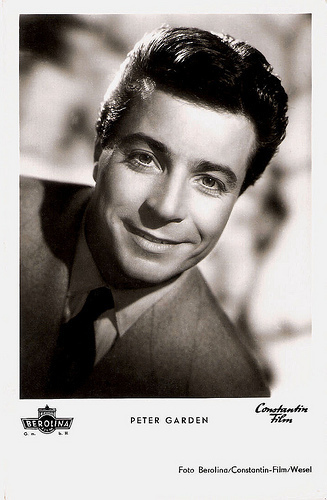
German postcard by Kunst und Bild, Berlin, no. T 631. Photo: Berolina / Constantin-Film / Wesel. Publicity still for Mein Leopold/My Leopold (Géza von Bolváry, 1955).
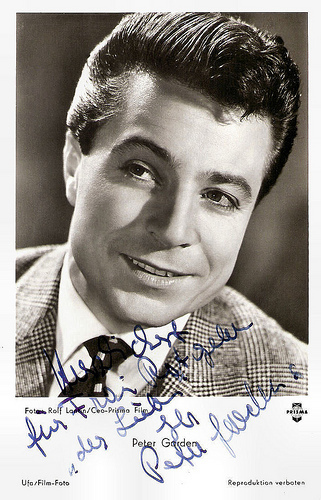
German postcard by Ufa, Berlin-Tempelhof, no. FK 3052. Photo: Rolf Lantin / Ceo-Prisma Film. Publicity still for Danny, bitte schreiben Sie/Danny, please write (Eduard von Borsody, 1956).
Gestapo-confident
In the late 1960s, Peter Garden was at the height of his popularity, but parallel to his rising television popularity his past caught up with him.
German Wikipedia writes that already in 1967 penal preliminary proceedings were opened in Berlin against him because of his behaviour during the Nazi period. There were several press reports about a dark, unknown past of the 'Sunny boy'. In 1944, Garden/Rothmayer had been active in Salzburg as a paid Gestapo confident.
One of his victims, Alexander Anders, was quoted in the German magazine Der Spiegel: Garden/Rothmayer had thrown "a row of outstanding Salzburg citizens and families in trouble and misery". As a result of Garden's denunciation, Anders himself was arrested in Salzburg by the Gestapo and was condemned by a special court to three-year prison because of listening to foreign radio stations.
Anders and the Salzburg actor Herbert Fux started a petition in Salzburg and other places with the aim to reach a dismissal of Garden as a TV-host by the ZDF (the Second German Television Channel). After this the ZDF and their 'Black Peter' separated their ways.
Garden disappeared nearly completely from the public view and tried his luck as an inventor. In the 1970s he patented strange inventions like extendable shoes and folding ski in the US.
Peter Garden and his wife Margit Nünke live in München (Munich), Germany.
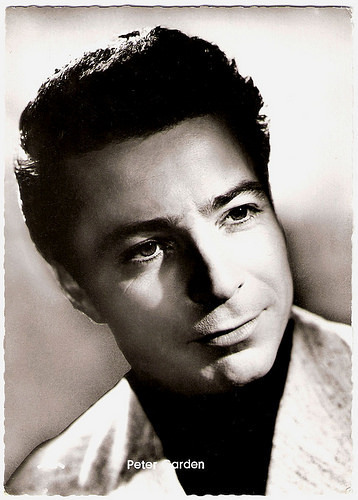
German postcard by JLB/Agfa, no. 512. Photo: Hoela / Panorama.
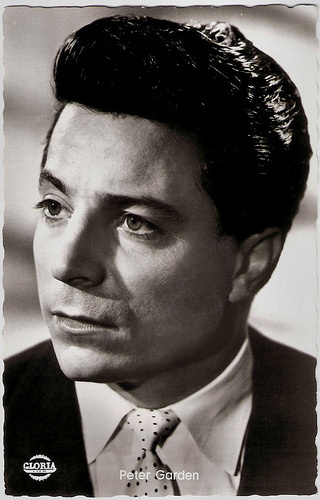
German postcard by Kolibri-Verlag, Minden/Westf., no. 2017. Photo: Gloria / Bayer. Publicity still for Kirschen in Nachbars Garten/Cherries in the neighbour's garden (Erich Engels, 1956).
Sources: Der Spiegel (German), Filmportal.de, Wikipedia (German) and .

German postcard by Ufa (Universum-Film Aktiengesellschaft), Berlin-Tempelhof, no. CK-87. Retail price: 30 Pfg. Photo: Arthur Grimm / Ufa.
Women's Hero
Peter Garden was born as Karlheinz Rothmayer in München (Munich), Germany, in 1924. He was the son of the singer Karl Rothmayer.
After his military service he attended the Musikhochschule Salzburg (the college of music in Salzburg) and in 1947, he went to the Volksoper München (the People's Opera Munich).
In the early 1950s he worked at the Bayerischen Staatsoperette (Bavarian state operetta). He also made his film debut at that time. After two years at the Stadttheater Bern (the Municipal theatre in Bern) he finished his stage career and returned to Munich to devote himself intensely to his film career.
He appeared in such comedies as Ein Herz bleibt allein/My Leopold (Géza van Bolváry, 1955), Ball im Savoy/Ball at the Savoy (Paul Martin, 1955) and Der Falsche Adam/The False Adam (Géza von Cziffra, 1955).
He posed shirtless for beefcake photos, and was groomed to become a romantic leading man like Rock Hudson in Hollywood. Garden grew to bigger roles in light entertainment films like Dany, bitte Schreiben Sie/Dany, Please Write (Eduard von Borsody, 1956) with Sonja Ziemann , Schön ist die Welt/Fair Is the World (Géza von Bolvary, 1957), and Egon, der Frauenheld/Egon, the Women's Hero (Hans Albin, 1957).
In 1959, he divorced his first wife, actress Christiane Jansen.

Dutch postcard. Photo: Berolina-Constantin-Wesel.

German postcard by Ufa-Film/foto, Berlin/Tempelhof, no. 3694. Retail price: 25 Pfg. Photo: Arthur Grimm.
Krimis
In the early 1960s the German cinema declined, and there were no more film roles for Peter Garden. He kept working for stage and TV.
As a singer he appeared in several TV-operettas like Viktoria und ihr Husar/Viktoria and her Hussar (1965) at the side of such stars as Johannes Heesters and Rudolf Schock .
He played in Krimis (the typical German crime series) like Das Kriminalmuseum (1963-1964), and in the musical Polenblut/Polish Blood (Wolfgang Liebeneiner, 1966).
He often performed together with his second wife, Margit Nünke, Miss Germany 1955 and Miss Europe 1956.
In the late 1960s, he was seen in dubious film comedies like Pudelnackt in Oberbayern/Completely Naked in Upper Bavaria (Hans Albin, Hans Billian, 1969) and Hugo der Weiberschreck/Hugo, the Woman Chaser (Hans Albin, 1969).
He fared better on television. As a TV host he had his own shows like Die Peter Garden Party (1969-1970) and Schwarzer Peter/Black Peter (1970).
He also worked as a singer and recorded the lp Herzlichst Ihr Peter Garden. He sang a duet with Margit Nünke, Jede Woche, die hat 7 Tage (Every Week Has Seven Days).

German postcard by Kunst und Bild, Berlin, no. T 631. Photo: Berolina / Constantin-Film / Wesel. Publicity still for Mein Leopold/My Leopold (Géza von Bolváry, 1955).

German postcard by Ufa, Berlin-Tempelhof, no. FK 3052. Photo: Rolf Lantin / Ceo-Prisma Film. Publicity still for Danny, bitte schreiben Sie/Danny, please write (Eduard von Borsody, 1956).
Gestapo-confident
In the late 1960s, Peter Garden was at the height of his popularity, but parallel to his rising television popularity his past caught up with him.
German Wikipedia writes that already in 1967 penal preliminary proceedings were opened in Berlin against him because of his behaviour during the Nazi period. There were several press reports about a dark, unknown past of the 'Sunny boy'. In 1944, Garden/Rothmayer had been active in Salzburg as a paid Gestapo confident.
One of his victims, Alexander Anders, was quoted in the German magazine Der Spiegel: Garden/Rothmayer had thrown "a row of outstanding Salzburg citizens and families in trouble and misery". As a result of Garden's denunciation, Anders himself was arrested in Salzburg by the Gestapo and was condemned by a special court to three-year prison because of listening to foreign radio stations.
Anders and the Salzburg actor Herbert Fux started a petition in Salzburg and other places with the aim to reach a dismissal of Garden as a TV-host by the ZDF (the Second German Television Channel). After this the ZDF and their 'Black Peter' separated their ways.
Garden disappeared nearly completely from the public view and tried his luck as an inventor. In the 1970s he patented strange inventions like extendable shoes and folding ski in the US.
Peter Garden and his wife Margit Nünke live in München (Munich), Germany.

German postcard by JLB/Agfa, no. 512. Photo: Hoela / Panorama.

German postcard by Kolibri-Verlag, Minden/Westf., no. 2017. Photo: Gloria / Bayer. Publicity still for Kirschen in Nachbars Garten/Cherries in the neighbour's garden (Erich Engels, 1956).
Sources: Der Spiegel (German), Filmportal.de, Wikipedia (German) and .
Published on March 07, 2015 22:00
March 6, 2015
Dave and Dusty (1946-1949)
Dave and Dusty (1946-1949) is a series of short British films chronicling the friendship between a young boy and his shaggy dog. The two friends get into trouble and have various adventures, meeting a host of colourful characters along the way. Raphael Tuck & Sons published a series of black and white postcards of the popular duo, apparently in aid of The Tailwaggers animal charity.
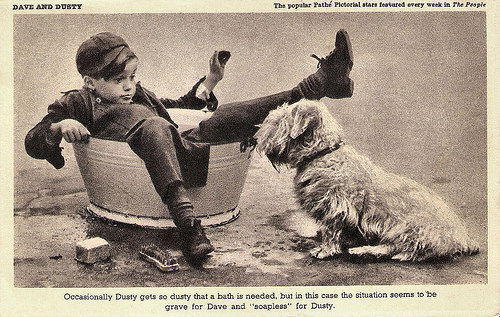
British postcard by Raphael Tuck & Sons. Photo: Pathé Pictorial. Publicity still for Dave and Dusty (1946-1949).
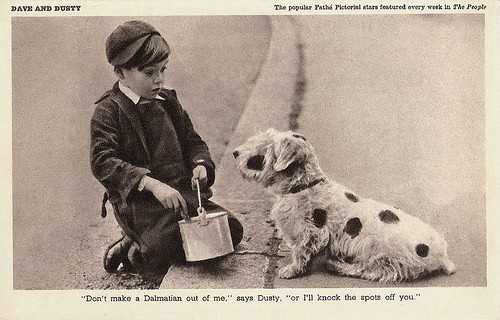
British postcard by Raphael Tuck & Sons. Photo: Pathé Pictorial. Publicity still for Dave and Dusty (1946-1949).
Cinemagazine
Between 16 December 1946 and 9 May 1949, Dave and Dusty were the cute stars of New Pictorial, a weekly cinemagazine by British Pathé.
They were also featured in the weekly newspaper The People. For a while Dave and Dusty were ‘Britain's Most Popular Film Pair’, according to a book which was published about them in 1948.
The series started on 16 December 1946 with the short film Dave Meets Dusty.
Dave stands outside a pet shop window and looks in at a little shaggy dog. The dog looks back and licks the glass between them. Dave goes inside and asks to have a look at the dog. A girl fetches the pup and puts it in Dave's arms.
Dave counts out his savings and finds he hasn't quite enough to pay for the dog. The woman at the counter says she will pay the balance. Dave decides to call the dog Dusty. He ties a piece of string to Dusty's collar and walks out of the shop with him.
Dusty looks a trifle reluctant to be led. Outside the shop Dave picks up his new dog and gives him a cuddle as he walks down the street.
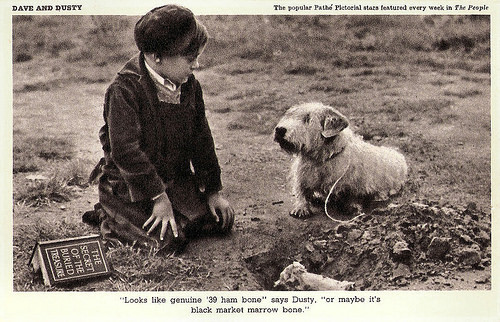
British postcard by Raphael Tuck & Sons. Photo: Pathé Pictorial. Publicity still for Dave and Dusty (1946-1949).
Tailwaggers
Where the first film was shot is unknown: “Location of events unknown probably somewhere in London’, writes the British Pathé site, where all the Dusty and Dave adventures can be seen.
A further adventure takes place in the beach town Brighton in East Sussex.
Dave and Dusty are lying on the beach, Dave is asleep. The waves start to roll up the beach. Dusty looks concerned as the waves come nearer, but Dave sleeps peacefully. When the waves come up to his feet, Dusty licks his face to wake him up.
Dave looks shocked at how far the water has come up and runs off with Dusty. Dave was played by little David Warner.
One of the black and white postcards by Tuck’s shows him sitting on a bench with Dusty on his lap. The postcard is captioned: "Dusty's a faithful dog, and when he gets on Dave's knees, he thinks he's in the lap of luxury."
On some of the postcards there is an advertisement for The Tailwaggers animal charity.
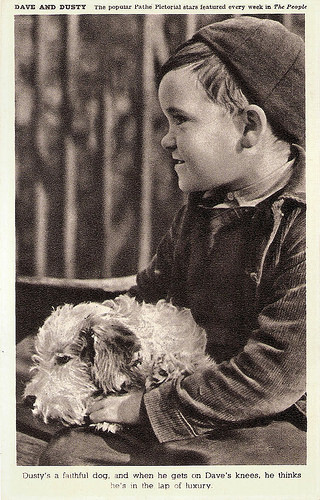
British postcard by Raphael Tuck & Sons. Photo: Pathé Pictorial. Publicity still for Dave and Dusty (1946-1949).
Pathé Pictorial
First released in March 1918, Pathe Pictorial was the longest running series in the history of the British cinemagazine, in continuous production for over fifty years.
It established the general format of the genre, focusing on stories of general interest, acting as a supplement to the company’s newsreel Pathe Gazette. Its longevity can partly be explained by its willingness to adapt and re-brand itself although to the audience it was always Pathe Pictorial.
In October 1931 (issue no. 704) it finally absorbed sound to transform into Pathe Sound Pictorial. In 1936 it became New Series Pictorial, which was shortened to New Pictorial in 1944. As well as producing regular news stories, British Pathé often included in the New Pictorial additional forms of entertainment mixed in to add a bit of variety.
These could be entirely fictional pieces such as Dave and Dusty. Production manager at the time was Howard Thomas and the editor was Terry Ashwood.
As competition from television became more heated in the mid 1950s, colour was introduced in January 1955 to mark its topical stories out from its rival.
By the introduction of colour television in the mid 1960s the days of the cinemagazines were numbered. Pathe Pictorial finally ceased production in March 1969.
Dave Meets Dusty (1946). Source: British Pathé (YouTube).
Dave And Dusty (1948). Source: British Pathé (YouTube).
Sources: British Universities Film & Video Council, The Bill Douglas Cinema Museum, and British Pathé.

British postcard by Raphael Tuck & Sons. Photo: Pathé Pictorial. Publicity still for Dave and Dusty (1946-1949).

British postcard by Raphael Tuck & Sons. Photo: Pathé Pictorial. Publicity still for Dave and Dusty (1946-1949).
Cinemagazine
Between 16 December 1946 and 9 May 1949, Dave and Dusty were the cute stars of New Pictorial, a weekly cinemagazine by British Pathé.
They were also featured in the weekly newspaper The People. For a while Dave and Dusty were ‘Britain's Most Popular Film Pair’, according to a book which was published about them in 1948.
The series started on 16 December 1946 with the short film Dave Meets Dusty.
Dave stands outside a pet shop window and looks in at a little shaggy dog. The dog looks back and licks the glass between them. Dave goes inside and asks to have a look at the dog. A girl fetches the pup and puts it in Dave's arms.
Dave counts out his savings and finds he hasn't quite enough to pay for the dog. The woman at the counter says she will pay the balance. Dave decides to call the dog Dusty. He ties a piece of string to Dusty's collar and walks out of the shop with him.
Dusty looks a trifle reluctant to be led. Outside the shop Dave picks up his new dog and gives him a cuddle as he walks down the street.

British postcard by Raphael Tuck & Sons. Photo: Pathé Pictorial. Publicity still for Dave and Dusty (1946-1949).
Tailwaggers
Where the first film was shot is unknown: “Location of events unknown probably somewhere in London’, writes the British Pathé site, where all the Dusty and Dave adventures can be seen.
A further adventure takes place in the beach town Brighton in East Sussex.
Dave and Dusty are lying on the beach, Dave is asleep. The waves start to roll up the beach. Dusty looks concerned as the waves come nearer, but Dave sleeps peacefully. When the waves come up to his feet, Dusty licks his face to wake him up.
Dave looks shocked at how far the water has come up and runs off with Dusty. Dave was played by little David Warner.
One of the black and white postcards by Tuck’s shows him sitting on a bench with Dusty on his lap. The postcard is captioned: "Dusty's a faithful dog, and when he gets on Dave's knees, he thinks he's in the lap of luxury."
On some of the postcards there is an advertisement for The Tailwaggers animal charity.

British postcard by Raphael Tuck & Sons. Photo: Pathé Pictorial. Publicity still for Dave and Dusty (1946-1949).
Pathé Pictorial
First released in March 1918, Pathe Pictorial was the longest running series in the history of the British cinemagazine, in continuous production for over fifty years.
It established the general format of the genre, focusing on stories of general interest, acting as a supplement to the company’s newsreel Pathe Gazette. Its longevity can partly be explained by its willingness to adapt and re-brand itself although to the audience it was always Pathe Pictorial.
In October 1931 (issue no. 704) it finally absorbed sound to transform into Pathe Sound Pictorial. In 1936 it became New Series Pictorial, which was shortened to New Pictorial in 1944. As well as producing regular news stories, British Pathé often included in the New Pictorial additional forms of entertainment mixed in to add a bit of variety.
These could be entirely fictional pieces such as Dave and Dusty. Production manager at the time was Howard Thomas and the editor was Terry Ashwood.
As competition from television became more heated in the mid 1950s, colour was introduced in January 1955 to mark its topical stories out from its rival.
By the introduction of colour television in the mid 1960s the days of the cinemagazines were numbered. Pathe Pictorial finally ceased production in March 1969.
Dave Meets Dusty (1946). Source: British Pathé (YouTube).
Dave And Dusty (1948). Source: British Pathé (YouTube).
Sources: British Universities Film & Video Council, The Bill Douglas Cinema Museum, and British Pathé.
Published on March 06, 2015 22:00
March 5, 2015
Susan Denberg
German-born Austrian Susan Denberg (1944) was a Bluebell dancer and Playboy Playmate before she had a brief acting career in the 1960s. One of her few roles was as Peter Cushing’s beautiful new creation in the Hammer horror Frankenstein Created Woman (1967).
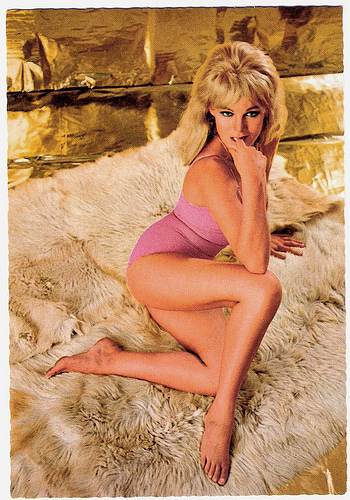
German postcard by ISV, Sort. 19/6.

Susan Denberg. Source: Vlad Quigley (Flickr).
Star Trek
Susan Denberg was born Dietlinde Ortrun Zechner in Bad Polzin, Germany (now Polczyn-Zdrój, Poland) in 1944. She was the eldest of three children of Austrian-German parents, and grew up with her two brothers, Reinhard and Ulrich, in Klagenfurt in Austria. Her father operated several electrical shops there.
At 18, she travelled to England to work as an au-pair. In 1963 she met a dancer of the Bluebell Girls and did an audition in Paris. She was hired for the chorus line and in 1964 and 1965, she performed in the Stardust Hotel in Las Vegas. There she met and married Latino singer Tony Scotti in 1965.
She deserted the Bluebells for a movie career in Hollywood, and landed a co-starring role as a German girl on the TV series 12 O'Clock High (1964-1967). This ABC drama set during World War II was the television version of the Oscar winning classic Twelve O'Clock High (Henry King, 1949) starring Gregory Peck.
The following year, Zechner made her feature film debut with a supporting role in An American Dream (Robert Gist, 1966). This trashy melodrama, based on a Norman Mailer novel, starred Stuart Whitman and Janet Leigh.
While working on this film, Warner Bros. held a nationwide contest to find Dietlinde a new screen name. They offered a $500 award to whoever came up with the best one. There were 5,000 entries, including ‘Norma Mailer’, but all were ultimately rejected. She herself came up with Susan Denberg.
Susan was featured Playmate of the Month for Playboy magazine's August 1966 issue. In her profile, Denberg stated that she had ambitions to become an actress. Denberg was later one of the finalists for the title of 1967s Playmate of the Year, though the title ultimately went to Lisa Baker.
Denberg's best known screen appearance was in the Star Trek episode Mudd’s Women (Harvey Hart, 1966). She played one of the three mysterious and stunningly beautiful women of the title, who have an odd effect on all the male crew of the Starship Enterprise (except Spock, who looks on bemused), causing involuntary arousal.
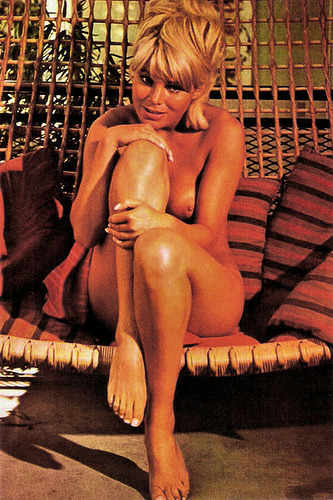
Spanish postcard by Editorial Filkasol.

Original French film poster for Frankenstein Created Woman (1967). Source: Vintage Movie Posters (Flickr).
Close To Something Sublime
Susan Denberg moved to England to play in Hammer's cult science fiction/horror film Frankenstein Created Woman (Terence Fisher, 1967). It is the fourth film in Hammer's Frankenstein series with Peter Cushing as Baron Frankenstein and Denberg as his new creation. Where Hammer's previous Frankenstein films were concerned with the physical aspects of the Baron's work, the interest here is in the metaphysical dimensions of life, such as the question of the soul, and its relationship to the body.
Frankenstein Created Woman is one of the most critically acclaimed Hammer films. Nick Faust at IMDb : “Within the confines of a Hammer movie's melodrama, Fisher, a classical stylist and at times a superb artist, often created magic. This is one of those times. The performances are all equally compelling. Cushing gives the Baron more texture here than in any of the other films, I think. Thorley Walters is a good foil, and his befuddled affection and respect for the Baron makes some of this really rather touching. Arthur Grant's photography has never been better. I urge viewers to watch the film with an open mind. This is not the usual horror film; it's more a fantasy, a fairy tale.”
Martin Scorsese picked the film as part of a 1987 National Film Theatre season of his favourite films, saying "If I single this one out it's because here they actually isolate the soul... The implied metaphysics are close to something sublime." However, Denberg's voice in the film was dubbed as her Austrian accent was considered too strong.
Denberg had become immersed in the drugs and sex life style of the 1960s. She divorced Tony Scotti in 1968. He later married singer/actress Sylvie Vartan .
She left show business and returned to Austria. Newspapers reported at the time that Denberg was suicidal and stayed in mental homes. During the 1970s she also performed in Viennese nightclubs.
Nowadays, Susan Denberg lives in Klagenfurt, Austria, under her real name, Dietlinde Zechner.
Trailer for Frankenstein Created Woman (1967). Source: Steven Duret (YouTube).
Sources: (IMDb), (IMDb), Nick Faust (IMDb), Glamour Girls of the Silver Screen, Wikipedia (English and German) and .

German postcard by ISV, Sort. 19/6.

Susan Denberg. Source: Vlad Quigley (Flickr).
Star Trek
Susan Denberg was born Dietlinde Ortrun Zechner in Bad Polzin, Germany (now Polczyn-Zdrój, Poland) in 1944. She was the eldest of three children of Austrian-German parents, and grew up with her two brothers, Reinhard and Ulrich, in Klagenfurt in Austria. Her father operated several electrical shops there.
At 18, she travelled to England to work as an au-pair. In 1963 she met a dancer of the Bluebell Girls and did an audition in Paris. She was hired for the chorus line and in 1964 and 1965, she performed in the Stardust Hotel in Las Vegas. There she met and married Latino singer Tony Scotti in 1965.
She deserted the Bluebells for a movie career in Hollywood, and landed a co-starring role as a German girl on the TV series 12 O'Clock High (1964-1967). This ABC drama set during World War II was the television version of the Oscar winning classic Twelve O'Clock High (Henry King, 1949) starring Gregory Peck.
The following year, Zechner made her feature film debut with a supporting role in An American Dream (Robert Gist, 1966). This trashy melodrama, based on a Norman Mailer novel, starred Stuart Whitman and Janet Leigh.
While working on this film, Warner Bros. held a nationwide contest to find Dietlinde a new screen name. They offered a $500 award to whoever came up with the best one. There were 5,000 entries, including ‘Norma Mailer’, but all were ultimately rejected. She herself came up with Susan Denberg.
Susan was featured Playmate of the Month for Playboy magazine's August 1966 issue. In her profile, Denberg stated that she had ambitions to become an actress. Denberg was later one of the finalists for the title of 1967s Playmate of the Year, though the title ultimately went to Lisa Baker.
Denberg's best known screen appearance was in the Star Trek episode Mudd’s Women (Harvey Hart, 1966). She played one of the three mysterious and stunningly beautiful women of the title, who have an odd effect on all the male crew of the Starship Enterprise (except Spock, who looks on bemused), causing involuntary arousal.

Spanish postcard by Editorial Filkasol.

Original French film poster for Frankenstein Created Woman (1967). Source: Vintage Movie Posters (Flickr).
Close To Something Sublime
Susan Denberg moved to England to play in Hammer's cult science fiction/horror film Frankenstein Created Woman (Terence Fisher, 1967). It is the fourth film in Hammer's Frankenstein series with Peter Cushing as Baron Frankenstein and Denberg as his new creation. Where Hammer's previous Frankenstein films were concerned with the physical aspects of the Baron's work, the interest here is in the metaphysical dimensions of life, such as the question of the soul, and its relationship to the body.
Frankenstein Created Woman is one of the most critically acclaimed Hammer films. Nick Faust at IMDb : “Within the confines of a Hammer movie's melodrama, Fisher, a classical stylist and at times a superb artist, often created magic. This is one of those times. The performances are all equally compelling. Cushing gives the Baron more texture here than in any of the other films, I think. Thorley Walters is a good foil, and his befuddled affection and respect for the Baron makes some of this really rather touching. Arthur Grant's photography has never been better. I urge viewers to watch the film with an open mind. This is not the usual horror film; it's more a fantasy, a fairy tale.”
Martin Scorsese picked the film as part of a 1987 National Film Theatre season of his favourite films, saying "If I single this one out it's because here they actually isolate the soul... The implied metaphysics are close to something sublime." However, Denberg's voice in the film was dubbed as her Austrian accent was considered too strong.
Denberg had become immersed in the drugs and sex life style of the 1960s. She divorced Tony Scotti in 1968. He later married singer/actress Sylvie Vartan .
She left show business and returned to Austria. Newspapers reported at the time that Denberg was suicidal and stayed in mental homes. During the 1970s she also performed in Viennese nightclubs.
Nowadays, Susan Denberg lives in Klagenfurt, Austria, under her real name, Dietlinde Zechner.
Trailer for Frankenstein Created Woman (1967). Source: Steven Duret (YouTube).
Sources: (IMDb), (IMDb), Nick Faust (IMDb), Glamour Girls of the Silver Screen, Wikipedia (English and German) and .
Published on March 05, 2015 22:00
March 4, 2015
Laurence Olivier
Sir Laurence Olivier (1907-1989) was one of the most famous and revered actors of the 20th century. He played a wide variety of roles on stage and screen from Greek tragedy, Shakespeare and Restoration comedy to modern American and British drama. The Brit got fourteen Oscar nominations, with two wins for Best Actor and Best Picture for Hamlet (1948), and two honorary awards.
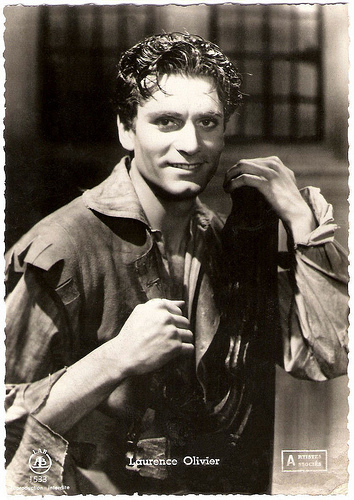
Belgian Postcard by Les Editions d’Art L.A.B., Brussels, no. 1533. Photo: United Artists. Publicity still for Fire Over England (William K. Howard, 1937).
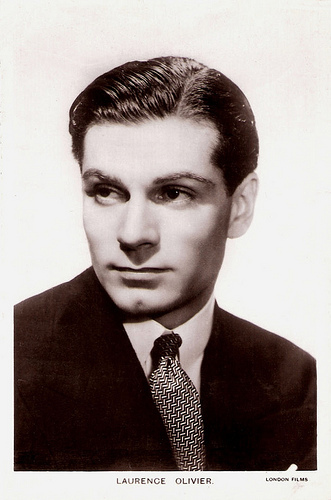
British postcard in the Picturegoer Series, London, no. 695b. Photo: London Films.
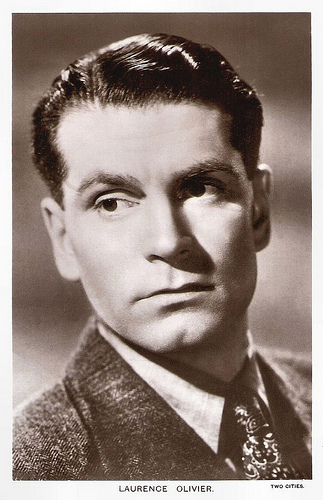
British postcard in the Picturegoer Series, London, no. W 228. Photo: Two Cities.
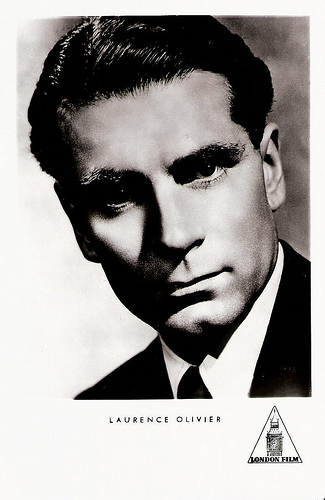
German postcard by Netter's Star Verlag, Berlin. Photo: London Film.
The Next Ronald Colman
Laurence Kerr Olivier was born in Dorking, England, in 1907. He was raised in a severe, strict, and religious household, ruled over by his father, Gerard Kerr Olivier, an Anglican minister. Larry took solace in the care of his mother, Agnes Louis née Crookenden, and was grief-stricken when she died when he was only 12.
A year later, he went to St. Edward's School in Oxford and appeared in school drama productions. At 15, he played Katherine in The Taming of the Shrew to rave reviews. Another success was his Puck in A Midsummer's Night Dream.
His father, who was an unabashed theatre lover, decided that Larry would become an actor. He entered the Central School of Speech Training and Dramatic Arts in London at the age of 17. One of his instructors was Claude Rains .
Upon graduation in 1926, he joined The Birmingham Repertory Company, where he would play Hamlet and Macbeth. He married actress Jill Esmond in 1930, but the marriage was not happy.
At first, Olivier's athleticism and elegant features typecast him as a young innocent hero. Although he appeared in a spate of London successes, such as Journey's End, The Last Enemy and Private Lives, he still struggled for serious recognition.
The good looking Olivier made his film debut opposite Lilian Harvey in The Temporary Widow (Gustav Ucicky, 1930). He went to Hollywood as the ‘next Ronald Colman ’ but initially he held the cinema in little regard.
He played a lead in The Yellow Ticket (Raoul Walsh, 1931), and was chosen to play Antonio in Queen Christina (Rouben Mamoulian, 1933) but was rejected by the star, Greta Garbo .
He returned to London and played opposite Gloria Swanson in Perfect Understanding (Cyril Gardner, 1933). In 1935 he had his stage breakthrough in Romeo and Juliet, alternating the roles of Romeo and Mercutio with John Gielgud .
This resulted in an invitation to be the star at the Old Vic in 1937/1938. His tenure had mixed artistic results, but by the season's end he was one of the major Shakespearean actors in England. He made his first Shakespeare film adaptation, As You Like It (Paul Czinner, 1936), but he decided that Shakespeare did not work well on film.
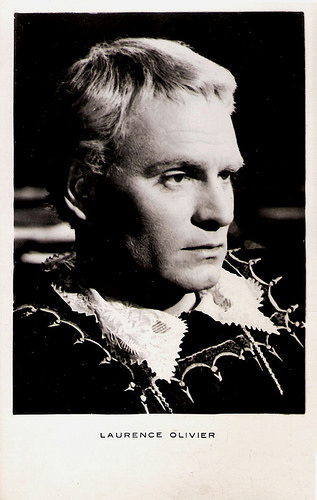
Yugoslavian postcard. Photo: Victory Rank. Publicity still for Hamlet (Laurence Olivier, 1948).

Italian postcard by Bromofoto, Milano, no. 214. Photo: Victory Rank. Publicity still for Hamlet (Laurence Olivier, 1948).
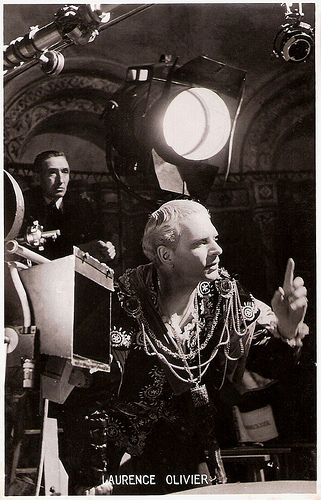
British postcard by Rotary Photo, London, no. F.S.5. Photo: Laurence Olivier directs a scene in Hamlet (1948).
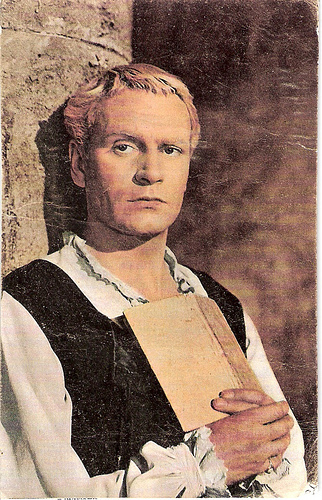
Spanish card by F. Molina, Madrid. D.L.M. 7.803/59. Photo: still from Hamlet (1948).
Turning Point
Laurence Olivier saw Vivien Leigh in The Mask of Virtue in 1936, and a friendship developed after he congratulated her on her performance. They played lovers in the film Fire Over England (William K. Howard, 1937). In private the (both married) actors also began an affair.
After the shooting of the film, Olivier travelled to Hollywood to play Heathcliff in Wuthering Heights (William Wyler, 1939). Leigh followed soon to be with him ánd to persue her dream of playing Scarlett O'Hara in Gone with the Wind (Victor Fleming, 1939).
The filming of Wuthering Heights proved to be a turning point for Olivier; both in his success in the USA, which had eluded him until then, but also in his attitude to film, which he had regarded as an inferior medium. He began to moderate his performance and began to appreciate the possibilities film offered.
Wuthering Heights was a hit and Olivier was nominated for an Oscar. Leigh won the Oscar for Gone with the Wind, and the couple suddenly found themselves to be major celebrities. They were married in 1940.
Oliviers film career flourished with highly regarded performances in Rebecca (Alfred Hitchcock, 1940) and Pride and Prejudice (Robert Z. Leonard, 1940). In That Hamilton Woman (Alexander Korda, 1941), he played Horatio Nelson and Leigh Emma Hamilton.
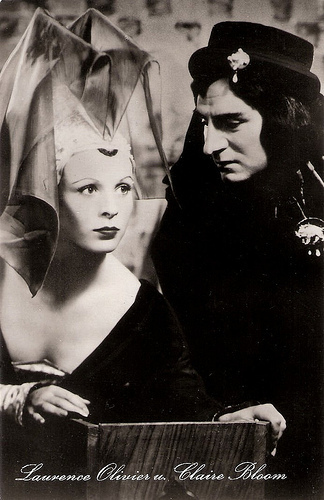
East-German postcard by VEB Progress Film-Vertrieb, Berlin, no. 1099. Photo: publicity still for Richard III (Laurence Olivier, 1955) with Claire Bloom .
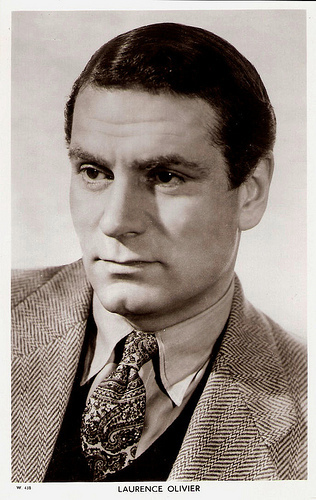
British postcard in the Picturegoer Series, London, no. W 438.
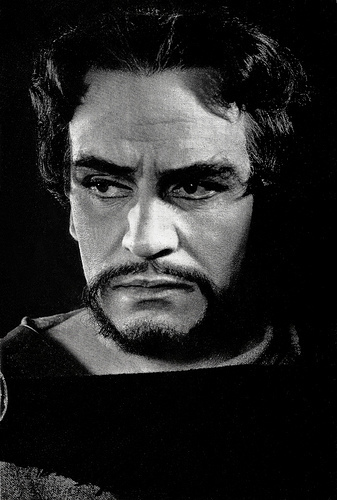
British postcard in the Royal Shakespeare Company series, no. 27. Photo: Angus McBean. Publicity still for the stage production of MacBeth at Stratford-upon-Avon in 1955.
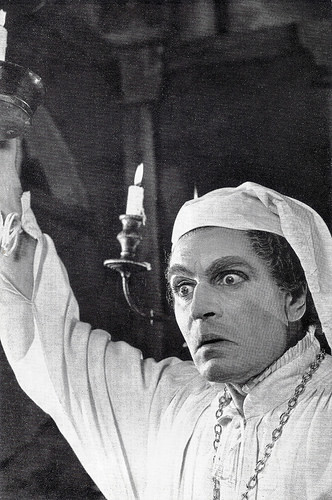
British postcard in the Royal Shakespeare Company series, no. 28. Photo: Angus McBean. Publicity still for the stage production of Twelfth Night at Stratford-upon-Avon in 1955.
In Character
When Britain engaged in World War II, the Oliviers returned to England. In 1944 he made his film directing debut with an adaptation of Shakespeare's Henry V. James C. Robertson writes in Reference Guide to British and Irish Film Directors: "With a lavish budget for the time, Henry V is beautifully filmed in Technicolor, draws on an excellent cast, and benefits from William Walton's stirring but unobtrusive music. Olivier's central performance is impeccable, while the battle sequences provide a spectacular climax."
After being knighted in 1947, Olivier adapted Hamlet (1948), again for his own film company Two Cities. James C. Robertson writes: "He drastically shortened Shakespeare's text but with much less visual action, the film appealed less to audiences than the flamboyant Henry V. Even so, Desmond Dickinson's imaginative monochrome cinematography, which helps create a brooding atmosphere of suppressed tension, is impressive, and Olivier assembles a fine cast and gives a memorable performance himself as Hamlet.".
Hamlet is still the only Shakespeare adaptation to win the Best Picture Oscar. However, the failure of Olivier's Richard III (1955) to make back its money caused that he would never direct another Shakespearean film.
He was Oscar nominated again for his lead as the seedy, pathetic vaudevillian Archie Rice in The Entertainer (Tony Richardson, 1960). The role of Rice's daughter - both in the play and in the film - was played by Joan Plowright. Soon after the release of The Entertainer he divorced Vivien Leigh, and married Plowright.
Years later, after Olivier's death, biographer Donald Spoto claimed that Olivier was bisexual. Plowright confirmed this and said he was once attached to Danny Kaye. Biographer Terry Coleman suggested that he also had had a relationship with Edwardian actor Henry Ainley .
During the 1960s, Olivier began appearing more frequently in films, usually in character parts, as in Spartacus (Stanley Kubrick, 1960), Bunny Lake Is Missing (Otto Preminger, 1965) and Oh! What a Lovely War (Richard Attenborough, 1969).
He received Oscar nominations for his reclusive mystery writer in Sleuth (Joseph L. Mankiewicz, 1972), the sadistic Nazi dentist in Marathon Man (John Schlesinger, 1976) and the kindly but determined Nazi-hunter The Boys from Brazil (Franklin J. Schaffner, 1978).
When he was forced out as director of the Royal National Theatre in 1973, he chose to do short film appearances on a ‘pay cheque’ basis. He later admitted that he particularly despised Inchon (Terence Young, 1982), in which he played General McArthur.
His final performance was a wheelchair-bound old soldier in War Requiem (Derek Jarman, 1989). Later that year Laurence Olivier died of cancer in Steyning, England, aged 82.
Fifteen years after his death, he returned to the cinema. Through the use of computer graphics footage of him was integrated into Sky Captain and the World of Tomorrow (Kerry Conran, 2004) in which Olivier 'played' the villain.
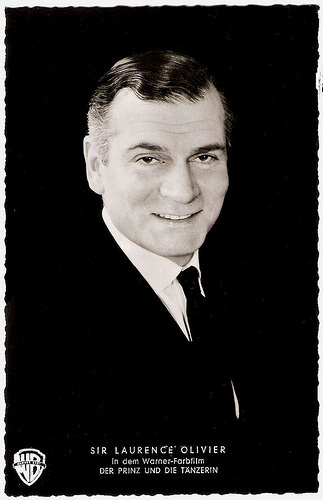
German postcard by Kunst und Bild, Berlin-Charlottenburg, no. V 176. Photo: Warner Brothers. Publicity still for The Prince and the Showgirl (Laurence Olivier, 1957).
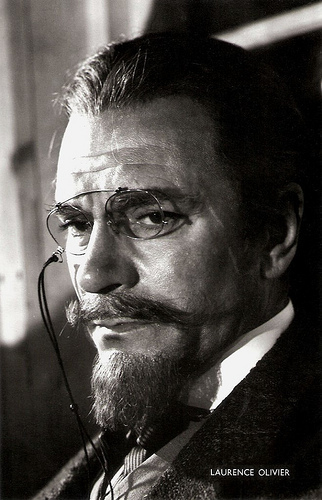
British card. Photo: publicity still for the stage play Uncle Vanya in 1963.
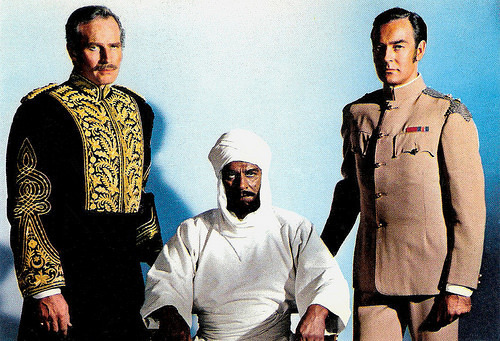
Italian postcard. Photo: Dear Film. Publicity still for Khartoum (Basil Dearden, Eliot Elisofon, 1965) with Charlton Heston and Richard Johnson.
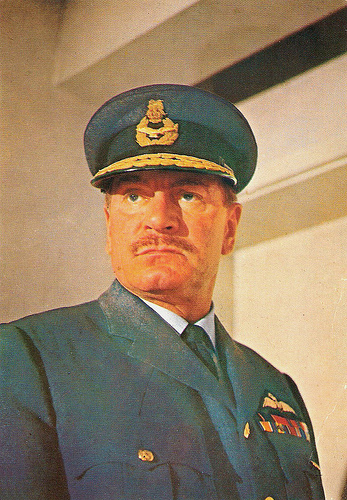
British postcard by Dixon-Lotus/Spitfire Productions Ltd, no. L6/8699, 1969. Photo: Robert Penn. Still for Battle of Britain (Guy Hamilton, 1969).
Sources: James C. Robertson (Reference Guide to British and Irish Film Directors), Hal Erickson (AllMovie), (IMDb), Wikipedia and .

Belgian Postcard by Les Editions d’Art L.A.B., Brussels, no. 1533. Photo: United Artists. Publicity still for Fire Over England (William K. Howard, 1937).

British postcard in the Picturegoer Series, London, no. 695b. Photo: London Films.

British postcard in the Picturegoer Series, London, no. W 228. Photo: Two Cities.

German postcard by Netter's Star Verlag, Berlin. Photo: London Film.
The Next Ronald Colman
Laurence Kerr Olivier was born in Dorking, England, in 1907. He was raised in a severe, strict, and religious household, ruled over by his father, Gerard Kerr Olivier, an Anglican minister. Larry took solace in the care of his mother, Agnes Louis née Crookenden, and was grief-stricken when she died when he was only 12.
A year later, he went to St. Edward's School in Oxford and appeared in school drama productions. At 15, he played Katherine in The Taming of the Shrew to rave reviews. Another success was his Puck in A Midsummer's Night Dream.
His father, who was an unabashed theatre lover, decided that Larry would become an actor. He entered the Central School of Speech Training and Dramatic Arts in London at the age of 17. One of his instructors was Claude Rains .
Upon graduation in 1926, he joined The Birmingham Repertory Company, where he would play Hamlet and Macbeth. He married actress Jill Esmond in 1930, but the marriage was not happy.
At first, Olivier's athleticism and elegant features typecast him as a young innocent hero. Although he appeared in a spate of London successes, such as Journey's End, The Last Enemy and Private Lives, he still struggled for serious recognition.
The good looking Olivier made his film debut opposite Lilian Harvey in The Temporary Widow (Gustav Ucicky, 1930). He went to Hollywood as the ‘next Ronald Colman ’ but initially he held the cinema in little regard.
He played a lead in The Yellow Ticket (Raoul Walsh, 1931), and was chosen to play Antonio in Queen Christina (Rouben Mamoulian, 1933) but was rejected by the star, Greta Garbo .
He returned to London and played opposite Gloria Swanson in Perfect Understanding (Cyril Gardner, 1933). In 1935 he had his stage breakthrough in Romeo and Juliet, alternating the roles of Romeo and Mercutio with John Gielgud .
This resulted in an invitation to be the star at the Old Vic in 1937/1938. His tenure had mixed artistic results, but by the season's end he was one of the major Shakespearean actors in England. He made his first Shakespeare film adaptation, As You Like It (Paul Czinner, 1936), but he decided that Shakespeare did not work well on film.

Yugoslavian postcard. Photo: Victory Rank. Publicity still for Hamlet (Laurence Olivier, 1948).

Italian postcard by Bromofoto, Milano, no. 214. Photo: Victory Rank. Publicity still for Hamlet (Laurence Olivier, 1948).

British postcard by Rotary Photo, London, no. F.S.5. Photo: Laurence Olivier directs a scene in Hamlet (1948).

Spanish card by F. Molina, Madrid. D.L.M. 7.803/59. Photo: still from Hamlet (1948).
Turning Point
Laurence Olivier saw Vivien Leigh in The Mask of Virtue in 1936, and a friendship developed after he congratulated her on her performance. They played lovers in the film Fire Over England (William K. Howard, 1937). In private the (both married) actors also began an affair.
After the shooting of the film, Olivier travelled to Hollywood to play Heathcliff in Wuthering Heights (William Wyler, 1939). Leigh followed soon to be with him ánd to persue her dream of playing Scarlett O'Hara in Gone with the Wind (Victor Fleming, 1939).
The filming of Wuthering Heights proved to be a turning point for Olivier; both in his success in the USA, which had eluded him until then, but also in his attitude to film, which he had regarded as an inferior medium. He began to moderate his performance and began to appreciate the possibilities film offered.
Wuthering Heights was a hit and Olivier was nominated for an Oscar. Leigh won the Oscar for Gone with the Wind, and the couple suddenly found themselves to be major celebrities. They were married in 1940.
Oliviers film career flourished with highly regarded performances in Rebecca (Alfred Hitchcock, 1940) and Pride and Prejudice (Robert Z. Leonard, 1940). In That Hamilton Woman (Alexander Korda, 1941), he played Horatio Nelson and Leigh Emma Hamilton.

East-German postcard by VEB Progress Film-Vertrieb, Berlin, no. 1099. Photo: publicity still for Richard III (Laurence Olivier, 1955) with Claire Bloom .

British postcard in the Picturegoer Series, London, no. W 438.

British postcard in the Royal Shakespeare Company series, no. 27. Photo: Angus McBean. Publicity still for the stage production of MacBeth at Stratford-upon-Avon in 1955.

British postcard in the Royal Shakespeare Company series, no. 28. Photo: Angus McBean. Publicity still for the stage production of Twelfth Night at Stratford-upon-Avon in 1955.
In Character
When Britain engaged in World War II, the Oliviers returned to England. In 1944 he made his film directing debut with an adaptation of Shakespeare's Henry V. James C. Robertson writes in Reference Guide to British and Irish Film Directors: "With a lavish budget for the time, Henry V is beautifully filmed in Technicolor, draws on an excellent cast, and benefits from William Walton's stirring but unobtrusive music. Olivier's central performance is impeccable, while the battle sequences provide a spectacular climax."
After being knighted in 1947, Olivier adapted Hamlet (1948), again for his own film company Two Cities. James C. Robertson writes: "He drastically shortened Shakespeare's text but with much less visual action, the film appealed less to audiences than the flamboyant Henry V. Even so, Desmond Dickinson's imaginative monochrome cinematography, which helps create a brooding atmosphere of suppressed tension, is impressive, and Olivier assembles a fine cast and gives a memorable performance himself as Hamlet.".
Hamlet is still the only Shakespeare adaptation to win the Best Picture Oscar. However, the failure of Olivier's Richard III (1955) to make back its money caused that he would never direct another Shakespearean film.
He was Oscar nominated again for his lead as the seedy, pathetic vaudevillian Archie Rice in The Entertainer (Tony Richardson, 1960). The role of Rice's daughter - both in the play and in the film - was played by Joan Plowright. Soon after the release of The Entertainer he divorced Vivien Leigh, and married Plowright.
Years later, after Olivier's death, biographer Donald Spoto claimed that Olivier was bisexual. Plowright confirmed this and said he was once attached to Danny Kaye. Biographer Terry Coleman suggested that he also had had a relationship with Edwardian actor Henry Ainley .
During the 1960s, Olivier began appearing more frequently in films, usually in character parts, as in Spartacus (Stanley Kubrick, 1960), Bunny Lake Is Missing (Otto Preminger, 1965) and Oh! What a Lovely War (Richard Attenborough, 1969).
He received Oscar nominations for his reclusive mystery writer in Sleuth (Joseph L. Mankiewicz, 1972), the sadistic Nazi dentist in Marathon Man (John Schlesinger, 1976) and the kindly but determined Nazi-hunter The Boys from Brazil (Franklin J. Schaffner, 1978).
When he was forced out as director of the Royal National Theatre in 1973, he chose to do short film appearances on a ‘pay cheque’ basis. He later admitted that he particularly despised Inchon (Terence Young, 1982), in which he played General McArthur.
His final performance was a wheelchair-bound old soldier in War Requiem (Derek Jarman, 1989). Later that year Laurence Olivier died of cancer in Steyning, England, aged 82.
Fifteen years after his death, he returned to the cinema. Through the use of computer graphics footage of him was integrated into Sky Captain and the World of Tomorrow (Kerry Conran, 2004) in which Olivier 'played' the villain.

German postcard by Kunst und Bild, Berlin-Charlottenburg, no. V 176. Photo: Warner Brothers. Publicity still for The Prince and the Showgirl (Laurence Olivier, 1957).

British card. Photo: publicity still for the stage play Uncle Vanya in 1963.

Italian postcard. Photo: Dear Film. Publicity still for Khartoum (Basil Dearden, Eliot Elisofon, 1965) with Charlton Heston and Richard Johnson.

British postcard by Dixon-Lotus/Spitfire Productions Ltd, no. L6/8699, 1969. Photo: Robert Penn. Still for Battle of Britain (Guy Hamilton, 1969).
Sources: James C. Robertson (Reference Guide to British and Irish Film Directors), Hal Erickson (AllMovie), (IMDb), Wikipedia and .
Published on March 04, 2015 22:00
March 3, 2015
Dick van Maarseveen
The Dutch photographer Dick van Maarseveen (1905-1990) was in the 1930s famous for his star portraits and film stills. After the war, he concentrated on corporate photography, but Van Maarseveen also moved in the field of advertising and fashion photography. In his spare time, he did nude photography. A special section of his oeuvre are the pictures he made as a prisoner of war in camp Muhlberg during World War II.
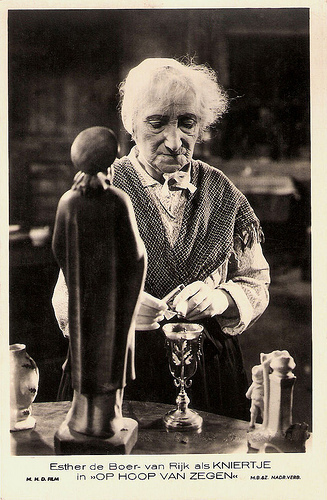
Esther de Boer-van Rijk . Dutch postcard by M.B. & Z. (M. Bonnist & Zonen, Amsterdam). Photo: Dick van Maarseveen, Den Haag / M.H.D. Film. Publicity still for Op Hoop van Zegen (Alex Benno, Louis Saalborn, 1934). Collection Egbert Barten.
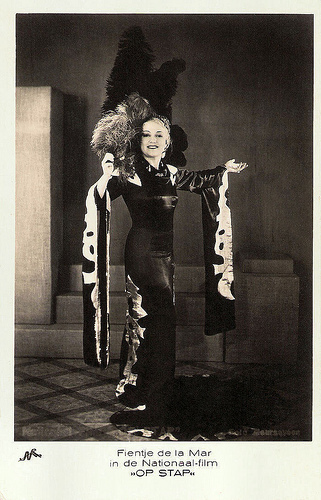
Fien(tje) de la Mar . Dutch postcard by M.B. & Z. (M. Bonnist & Zonen, Amsterdam). Photo: Dick van Maarseveen, Den Haag / Nationaal Film. Publicity still for Op stap/On the Move (Ernst Winar, 1935).
The international glamour portrait style
Dirk Willem Bastiaan (Dick) van Maarseveen was born in The Hague, The Netherlands, in 1905. In 1923 he went to work in the art trade firm of his parents as a list maker and seller of photo products. He got a slap IAG camera from his mother and started to photograph himself.
Moreover, he could take over a studio camera and some of the negative archives of photographer Adolphe Zimmermans, deceased in 1923. He got his first assignment by oil company Texaco.
In 1927, he moved into a studio on the Theresiastraat in The Hague, which he used especially for portrait photography. He worked as a photojournalist for the French magazine La Danse Theatre. Van Maarseveen won an honorable mention in 1930 on the anniversary exhibition of the Photographers Association of America and also won several awards in the following years.
In September 1931, Van Maarseveen moved to a new, luxury studio at the Bezuidenhout. Here he made a name as an artificial expert. He photographed many artists with whom he came into contact when he took care of the Amsterdam studio of portrait photographer Godfried de Groot during his holidays.
Rob van den Berg at ScherpteDiepte : "In the studio of Godfried de Groot , he developed technical skills in portraiture. There he met the international glamour portrait style, whose influence was visible in his work." Under the influence of the glamour photography that blew over the fashion and film industry, he always used back lighting, which strongly emerged the subject.
He produced photographs for the dance group of Darja Collin, who led a famous dance studio in The Hague. The quality of his pictures was so that many artists in the following years, preferred to be photographed by him.
Through his contacts with actors, he entered the film industry. After a cautious start in 1931, Van Maarseveen became the leading Dutch still photographer in the years 1933-1936. During the heyday of 'Hollands Hollywood’, he was the main still photographer.
Van Maarseveen was also engaged in advertising photography. Business was so good that Van Maarseveen had four staff members employed. These years formed a peak and almost simultaneously a conclusion of his most creative period.
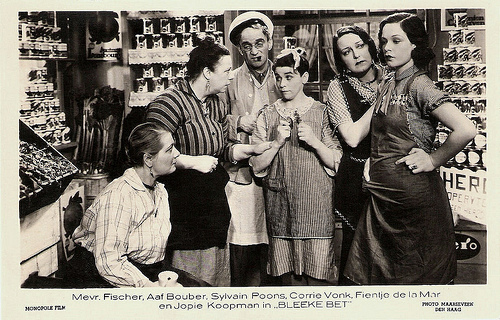
Dutch postcard by Monopole Film, Amsterdam. Photo: Maarseveen, Den Haag. Clara Vischer-Blaaser, Aaf Bouber, Sylvain Poons, Corry Vonk, Fien de la Mar and Jopie Koopman in the Dutch tragicomedy Bleeke Bet (Richard Oswald, Alex Benno, 1934).
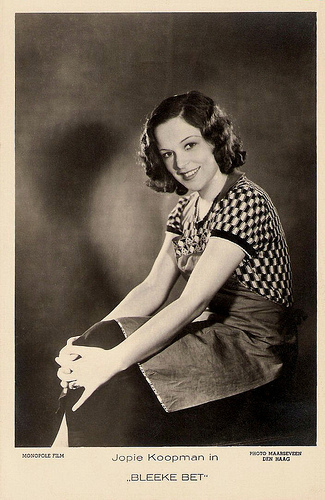
Jopie Koopman . Dutch postcard by Monopole Film, Rotterdam. Photo: Dick van Maarseveen. Still for Bleeke Bet (Alex Benno, Richard Oswald, 1934). Collection: Egbert Barten.
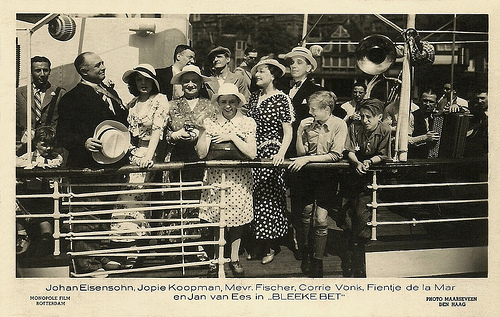
Dutch postcard by Monopole Film, Amsterdam. Photo: Maarseveen, Den Haag. Johan Elsensohn, Jopie Koopman , Clara Vischer-Blaaser, Corry Vonk, Fien de la Mar and Jan van Ees in the Dutch tragicomedy Bleeke Bet (Richard Oswald, Alex Benno, 1934).
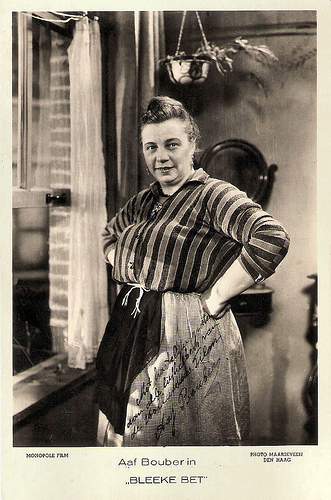
Aaf Bouber . Dutch postcard by M.B. & Z. (M. Bonnist & Zonen, Amsterdam). Photo: Dick van Maarseveen, Den Haag / Monopole Film. Publicity still for Bleeke Bet (Richard Oswald, Alex Benno, 1934). Collection: Egbert Barten.
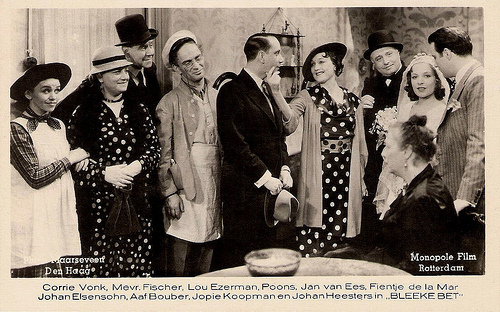
Dutch Postcard by Monopole Film, Rotterdam. Photo: Dick van Maarseveen, Den Haag (The Hague). Publicity still for Bleeke Bet (Richard Oswald, Alex Benno, 1934).
A big step back
Dick van Maarseveen worked on the set of such well-known Dutch films as Op stap/On the Move (Ernst Winar, 1935) starring Fien de la Mar , and Op hoop van zegen/The Good Hope (Alex Benno Louis Saalborn, 1934) with Esther de Boer van Rijk . He made popular portraits of these two stars. Van Maarseveen himself played a small supporting role in Op stap/On the Move (1935).
Van Maarseveen made more beautiful stills for films like Het mysterie van de Mondscheinsonate/The Mystery of the Moonlight Sonata (Kurt Gerron, 1935) and Rubber (Gerard Rutten, 1936). Van Maarseveen’s sharp image exposure was used gratefully for illuminating the set of the film Jonge harten/Young hearts (Charles Huguenot of Linden, 1936).
But the economic slump in portrait photography and a backlash in the film industry caused Van Maarseveen to take a big step back in 1937. He dismissed three of the four members of his staff, sold the studio furniture and moved to a smaller studio at the Bezuidenhout. He took a job as a consultant at Kodak. In 1938, Van Maarseveen married with A.J. Bergenhenegouwen.
In the summer of the next year, Van Maarseveen had to go into the army because of the mobilization. After the capitulation by the Netherlands on 15 May 1940, he was interned for several days as a prisoner, but then he could return to his film studio. He was still employed by Kodak.
In the film area Van Maarseveen’s ambitions reached beyond still photography. He wanted to be a cameraman. With his friend the artist Alfred Mazure, he made two short films, which stayed unfinished: De gasman/The gasman (Alfred Mazure, 1942) and Vals geld/Counterfeit (Alfred Mazure, 1942) both with Maurice van Nieuwenhuizen as Dick Bos. He also made two enthusiastically received ‘job films' for Schoevers Institute in The Hague.
The stricter control of the Germans on the Dutch film industry blocked for Van Maarseveen a career in this field. On 29 April 1943, the German occupiers decided to take all Dutch soldiers from May 1940 in captivity. Van Maarseveen was deported to Germany.
He spent the bulk of his time in Mühlberg on the Elbe. His camp, Stalag IVB, was a model camp where the Germans wanted to show the world how well they treated their prisoners of war. In June 1944, after about a year of camp life, he could work as a photographer for the camp. Along with some other prisoners, including his Dutch colleague Cor van Weele, Van Maarseveen was instructed to photograph all kinds of official events in the camp, such as religious activities, theater evenings and sport and to make passport photos of the new arrivals. He also made clandestine photos.
Mühlberg camp was liberated by the Russians on 23 April 1945. Maarseveen brought photographs and glass negatives back home. In The Hague, his studio at the Bezuidenhout was in a section of the street that passed the war, but it was ‘purged’ during the bombardment of March 1945, leaving his archive partially lost.
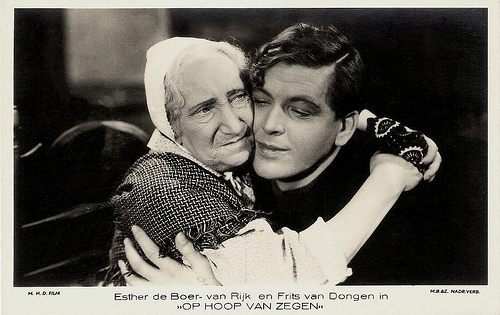
Esther de Boer-van Rijk and Frits van Dongen (Philip Dorn). Dutch postcard by M.B. & Z / M.H.D. Film. Photo: Maarseveen, Den Haag. Publicity still for Op hoop van zegen/The Good Hope (Alex Benno, 1934).
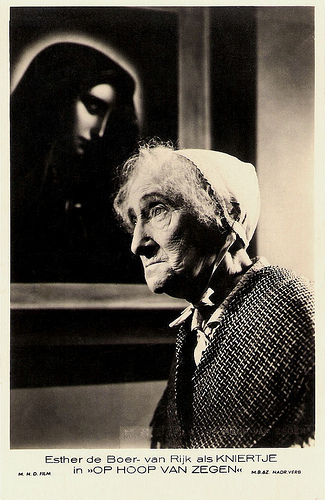
Esther de Boer-van Rijk . Dutch postcard by M.B. & Z / M.H.D. Film. Photo: Maarseveen, Den Haag. Publicity still for Op hoop van zegen/The Good Hope (Alex Benno, 1934).
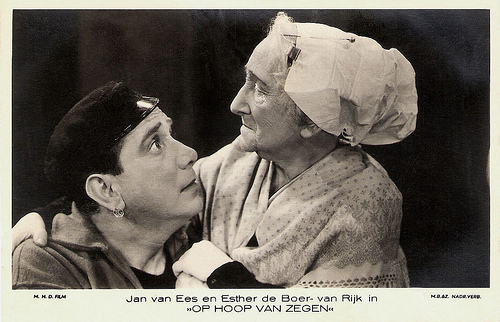
Jan van Ees and Esther de Boer-van Rijk . Dutch postcard by M.B. & Z. (M. Bonnist & Zonen, Amsterdam). Photo: Dick van Maarseveen, Den Haag/M.H.D. Film. Publicity still for Op Hoop van Zegen (1934, Alex Benno, Louis Saalborn). Collection Egbert Barten.
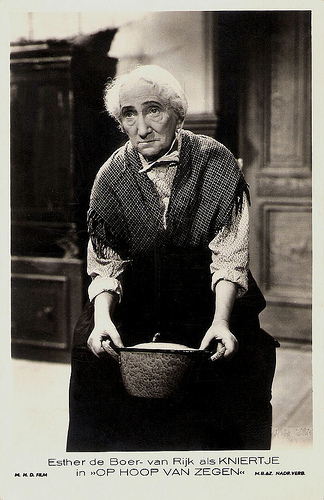
Esther de Boer-van Rijk . Dutch postcard by M.B. & Z / M.H.D. Film. Photo: Maarseveen, Den Haag. Publicity still for Op hoop van zegen/The Good Hope (Alex Benno, 1934). Collection: Egbert Barten.
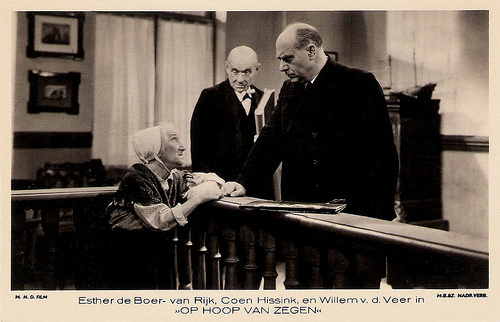
Dutch postcard by M.B. & Z. (M. Bonnist & Zonen, Amsterdam). Photo: Dick van Maarseveen, Den Haag/M.H.D. Film. Publicity still for Op Hoop van Zegen (Alex Benno, Louis Saalborn, 1934) with Esther de Boer-van Rijk , Coen Hissink and Willem v.d. Veer. Collection Egbert Barten.
Cecil Beaton
Dick van Maarseveen rebuilt his heavily damaged studio. After several years in which he gave the artistic portrait photography much attention, he concentrated largely on freelance work for industry and advertising. Already in 1925, he had laid contact with Texaco (from about 1947 to 1967 along with Chevron united in the operating company Caltex) which lead to a lengthy contract.
He worked part time for Kodak in London, where he learned to deal basically with color photography according to the new Ektachrome. He then spread the knowledge through courses in the Netherlands. In 1950, Van Maarseveen assisted British photographer Cecil Beaton, who was commissioned by Vogue magazine to portray the Dutch royal family.
In 1950s and 1960s he photographed 'herrijzend Nederland’ (resurgent Netherlands) and especially for Texaco he was regularly on the road. His activities ranged from making passport photos to 'stunt work' on oil rigs and high cranes in ports. Thanks to good relations in several church boards, he also photographed a number of interiors of churches.
In the 1960s, he was a board member of the Foundation Fotovakschool which emerged in the School of Photography and Photo Technology in The Hague and he was regularly in the examination committee. The oil crisis in 1973 made an end to his work for Texaco, but Van Maarseveen continued to work as a freelance photographer until 1978.
In 1978 he brought his collection of film stills under at the Dutch Filmmuseum in Amsterdam (now Eye Institute). In 1980, Van Maarseveen sold a part of his archive – his portraits, nudes and corporate photography - at the Prentenkabinet of the Rijksuniversiteit Leiden (Print Room of the University of Leiden). After an interview in 1982, his photographs from the camp period were rediscovered and housed at the Rijksmuseum in Amsterdam.
In 1990, Dick van Maarseveen died in his hometown Rijssen in the Netherlands.
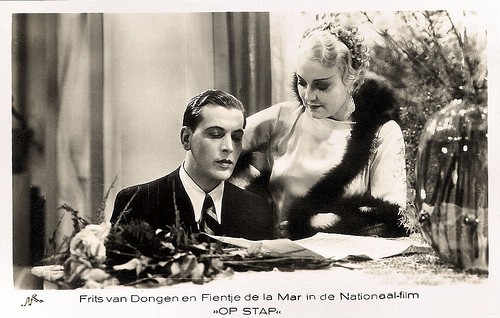
Frits van Dongen and Fien de la Mar . Dutch postcard by M.B. & Z. (M. Bonnist & Zonen, Amsterdam). Photo: Dick van Maarseveen, Den Haag / Nationaal Film. Publicity still for Op stap/On the Move (Ernst Winar, 1935).
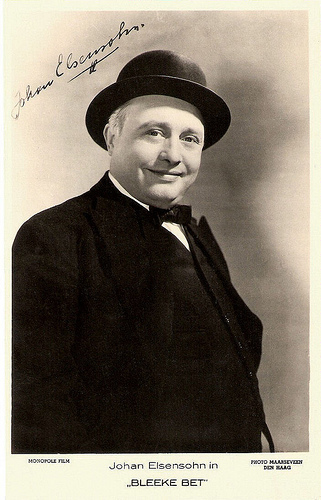
Johan Elsensohn . Dutch postcard by M.B. & Z. (M. Bonnist & Zonen, Amsterdam). Photo: Dick van Maarseveen, Den Haag/Monopole Film. Publicity still for Bleeke Bet (Richard Oswald, Alex Benno, 1934). Collection: Egbert Barten.
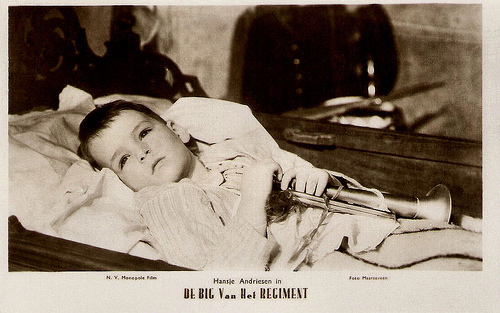
Hansje Andriesen. Dutch postcard by Monopole Film N.V. Photo: Dick van Maarseveen. Still for De Big van het Regiment (Max Nosseck, 1935). Collection: Egbert Barten.
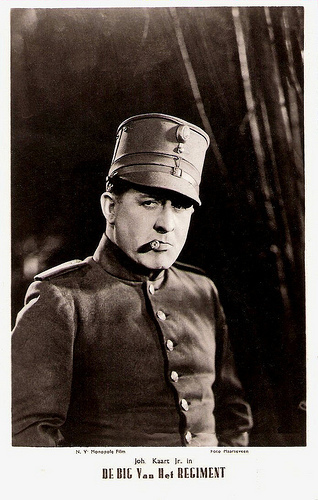
Johan Kaart . Dutch postcard by Monopole Film N.V. Photo: Dick van Maarseveen. Still for De Big van het Regiment (Max Nosseck, 1935). Collection: Egbert Barten.
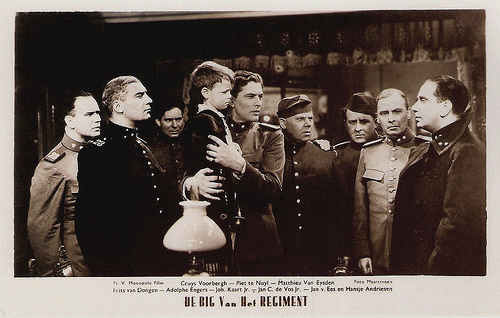
Dutch postcard by Monopole Film NV. Photo: Dick van Maarseveen. Still for De Big van het Regiment (Max Nosseck, 1935). Collection: Egbert Barten.
Check out our other posts on film star photographers. See the links at right under the caption 'The Photographers'.
Sources: Rob van den Berg (ScherpteDiepte - Dutch), Rijksmuseum (Dutch), Eye, RKD, Fotografen.nl and IMDb.

Esther de Boer-van Rijk . Dutch postcard by M.B. & Z. (M. Bonnist & Zonen, Amsterdam). Photo: Dick van Maarseveen, Den Haag / M.H.D. Film. Publicity still for Op Hoop van Zegen (Alex Benno, Louis Saalborn, 1934). Collection Egbert Barten.

Fien(tje) de la Mar . Dutch postcard by M.B. & Z. (M. Bonnist & Zonen, Amsterdam). Photo: Dick van Maarseveen, Den Haag / Nationaal Film. Publicity still for Op stap/On the Move (Ernst Winar, 1935).
The international glamour portrait style
Dirk Willem Bastiaan (Dick) van Maarseveen was born in The Hague, The Netherlands, in 1905. In 1923 he went to work in the art trade firm of his parents as a list maker and seller of photo products. He got a slap IAG camera from his mother and started to photograph himself.
Moreover, he could take over a studio camera and some of the negative archives of photographer Adolphe Zimmermans, deceased in 1923. He got his first assignment by oil company Texaco.
In 1927, he moved into a studio on the Theresiastraat in The Hague, which he used especially for portrait photography. He worked as a photojournalist for the French magazine La Danse Theatre. Van Maarseveen won an honorable mention in 1930 on the anniversary exhibition of the Photographers Association of America and also won several awards in the following years.
In September 1931, Van Maarseveen moved to a new, luxury studio at the Bezuidenhout. Here he made a name as an artificial expert. He photographed many artists with whom he came into contact when he took care of the Amsterdam studio of portrait photographer Godfried de Groot during his holidays.
Rob van den Berg at ScherpteDiepte : "In the studio of Godfried de Groot , he developed technical skills in portraiture. There he met the international glamour portrait style, whose influence was visible in his work." Under the influence of the glamour photography that blew over the fashion and film industry, he always used back lighting, which strongly emerged the subject.
He produced photographs for the dance group of Darja Collin, who led a famous dance studio in The Hague. The quality of his pictures was so that many artists in the following years, preferred to be photographed by him.
Through his contacts with actors, he entered the film industry. After a cautious start in 1931, Van Maarseveen became the leading Dutch still photographer in the years 1933-1936. During the heyday of 'Hollands Hollywood’, he was the main still photographer.
Van Maarseveen was also engaged in advertising photography. Business was so good that Van Maarseveen had four staff members employed. These years formed a peak and almost simultaneously a conclusion of his most creative period.

Dutch postcard by Monopole Film, Amsterdam. Photo: Maarseveen, Den Haag. Clara Vischer-Blaaser, Aaf Bouber, Sylvain Poons, Corry Vonk, Fien de la Mar and Jopie Koopman in the Dutch tragicomedy Bleeke Bet (Richard Oswald, Alex Benno, 1934).

Jopie Koopman . Dutch postcard by Monopole Film, Rotterdam. Photo: Dick van Maarseveen. Still for Bleeke Bet (Alex Benno, Richard Oswald, 1934). Collection: Egbert Barten.

Dutch postcard by Monopole Film, Amsterdam. Photo: Maarseveen, Den Haag. Johan Elsensohn, Jopie Koopman , Clara Vischer-Blaaser, Corry Vonk, Fien de la Mar and Jan van Ees in the Dutch tragicomedy Bleeke Bet (Richard Oswald, Alex Benno, 1934).

Aaf Bouber . Dutch postcard by M.B. & Z. (M. Bonnist & Zonen, Amsterdam). Photo: Dick van Maarseveen, Den Haag / Monopole Film. Publicity still for Bleeke Bet (Richard Oswald, Alex Benno, 1934). Collection: Egbert Barten.

Dutch Postcard by Monopole Film, Rotterdam. Photo: Dick van Maarseveen, Den Haag (The Hague). Publicity still for Bleeke Bet (Richard Oswald, Alex Benno, 1934).
A big step back
Dick van Maarseveen worked on the set of such well-known Dutch films as Op stap/On the Move (Ernst Winar, 1935) starring Fien de la Mar , and Op hoop van zegen/The Good Hope (Alex Benno Louis Saalborn, 1934) with Esther de Boer van Rijk . He made popular portraits of these two stars. Van Maarseveen himself played a small supporting role in Op stap/On the Move (1935).
Van Maarseveen made more beautiful stills for films like Het mysterie van de Mondscheinsonate/The Mystery of the Moonlight Sonata (Kurt Gerron, 1935) and Rubber (Gerard Rutten, 1936). Van Maarseveen’s sharp image exposure was used gratefully for illuminating the set of the film Jonge harten/Young hearts (Charles Huguenot of Linden, 1936).
But the economic slump in portrait photography and a backlash in the film industry caused Van Maarseveen to take a big step back in 1937. He dismissed three of the four members of his staff, sold the studio furniture and moved to a smaller studio at the Bezuidenhout. He took a job as a consultant at Kodak. In 1938, Van Maarseveen married with A.J. Bergenhenegouwen.
In the summer of the next year, Van Maarseveen had to go into the army because of the mobilization. After the capitulation by the Netherlands on 15 May 1940, he was interned for several days as a prisoner, but then he could return to his film studio. He was still employed by Kodak.
In the film area Van Maarseveen’s ambitions reached beyond still photography. He wanted to be a cameraman. With his friend the artist Alfred Mazure, he made two short films, which stayed unfinished: De gasman/The gasman (Alfred Mazure, 1942) and Vals geld/Counterfeit (Alfred Mazure, 1942) both with Maurice van Nieuwenhuizen as Dick Bos. He also made two enthusiastically received ‘job films' for Schoevers Institute in The Hague.
The stricter control of the Germans on the Dutch film industry blocked for Van Maarseveen a career in this field. On 29 April 1943, the German occupiers decided to take all Dutch soldiers from May 1940 in captivity. Van Maarseveen was deported to Germany.
He spent the bulk of his time in Mühlberg on the Elbe. His camp, Stalag IVB, was a model camp where the Germans wanted to show the world how well they treated their prisoners of war. In June 1944, after about a year of camp life, he could work as a photographer for the camp. Along with some other prisoners, including his Dutch colleague Cor van Weele, Van Maarseveen was instructed to photograph all kinds of official events in the camp, such as religious activities, theater evenings and sport and to make passport photos of the new arrivals. He also made clandestine photos.
Mühlberg camp was liberated by the Russians on 23 April 1945. Maarseveen brought photographs and glass negatives back home. In The Hague, his studio at the Bezuidenhout was in a section of the street that passed the war, but it was ‘purged’ during the bombardment of March 1945, leaving his archive partially lost.

Esther de Boer-van Rijk and Frits van Dongen (Philip Dorn). Dutch postcard by M.B. & Z / M.H.D. Film. Photo: Maarseveen, Den Haag. Publicity still for Op hoop van zegen/The Good Hope (Alex Benno, 1934).

Esther de Boer-van Rijk . Dutch postcard by M.B. & Z / M.H.D. Film. Photo: Maarseveen, Den Haag. Publicity still for Op hoop van zegen/The Good Hope (Alex Benno, 1934).

Jan van Ees and Esther de Boer-van Rijk . Dutch postcard by M.B. & Z. (M. Bonnist & Zonen, Amsterdam). Photo: Dick van Maarseveen, Den Haag/M.H.D. Film. Publicity still for Op Hoop van Zegen (1934, Alex Benno, Louis Saalborn). Collection Egbert Barten.

Esther de Boer-van Rijk . Dutch postcard by M.B. & Z / M.H.D. Film. Photo: Maarseveen, Den Haag. Publicity still for Op hoop van zegen/The Good Hope (Alex Benno, 1934). Collection: Egbert Barten.

Dutch postcard by M.B. & Z. (M. Bonnist & Zonen, Amsterdam). Photo: Dick van Maarseveen, Den Haag/M.H.D. Film. Publicity still for Op Hoop van Zegen (Alex Benno, Louis Saalborn, 1934) with Esther de Boer-van Rijk , Coen Hissink and Willem v.d. Veer. Collection Egbert Barten.
Cecil Beaton
Dick van Maarseveen rebuilt his heavily damaged studio. After several years in which he gave the artistic portrait photography much attention, he concentrated largely on freelance work for industry and advertising. Already in 1925, he had laid contact with Texaco (from about 1947 to 1967 along with Chevron united in the operating company Caltex) which lead to a lengthy contract.
He worked part time for Kodak in London, where he learned to deal basically with color photography according to the new Ektachrome. He then spread the knowledge through courses in the Netherlands. In 1950, Van Maarseveen assisted British photographer Cecil Beaton, who was commissioned by Vogue magazine to portray the Dutch royal family.
In 1950s and 1960s he photographed 'herrijzend Nederland’ (resurgent Netherlands) and especially for Texaco he was regularly on the road. His activities ranged from making passport photos to 'stunt work' on oil rigs and high cranes in ports. Thanks to good relations in several church boards, he also photographed a number of interiors of churches.
In the 1960s, he was a board member of the Foundation Fotovakschool which emerged in the School of Photography and Photo Technology in The Hague and he was regularly in the examination committee. The oil crisis in 1973 made an end to his work for Texaco, but Van Maarseveen continued to work as a freelance photographer until 1978.
In 1978 he brought his collection of film stills under at the Dutch Filmmuseum in Amsterdam (now Eye Institute). In 1980, Van Maarseveen sold a part of his archive – his portraits, nudes and corporate photography - at the Prentenkabinet of the Rijksuniversiteit Leiden (Print Room of the University of Leiden). After an interview in 1982, his photographs from the camp period were rediscovered and housed at the Rijksmuseum in Amsterdam.
In 1990, Dick van Maarseveen died in his hometown Rijssen in the Netherlands.

Frits van Dongen and Fien de la Mar . Dutch postcard by M.B. & Z. (M. Bonnist & Zonen, Amsterdam). Photo: Dick van Maarseveen, Den Haag / Nationaal Film. Publicity still for Op stap/On the Move (Ernst Winar, 1935).

Johan Elsensohn . Dutch postcard by M.B. & Z. (M. Bonnist & Zonen, Amsterdam). Photo: Dick van Maarseveen, Den Haag/Monopole Film. Publicity still for Bleeke Bet (Richard Oswald, Alex Benno, 1934). Collection: Egbert Barten.

Hansje Andriesen. Dutch postcard by Monopole Film N.V. Photo: Dick van Maarseveen. Still for De Big van het Regiment (Max Nosseck, 1935). Collection: Egbert Barten.

Johan Kaart . Dutch postcard by Monopole Film N.V. Photo: Dick van Maarseveen. Still for De Big van het Regiment (Max Nosseck, 1935). Collection: Egbert Barten.

Dutch postcard by Monopole Film NV. Photo: Dick van Maarseveen. Still for De Big van het Regiment (Max Nosseck, 1935). Collection: Egbert Barten.
Check out our other posts on film star photographers. See the links at right under the caption 'The Photographers'.
Sources: Rob van den Berg (ScherpteDiepte - Dutch), Rijksmuseum (Dutch), Eye, RKD, Fotografen.nl and IMDb.
Published on March 03, 2015 22:00
March 2, 2015
Georges Biscot
Georges Biscot (1886-1945) was a popular French music-hall and revue singer and actor, who also knew a career in French silent and sound film.
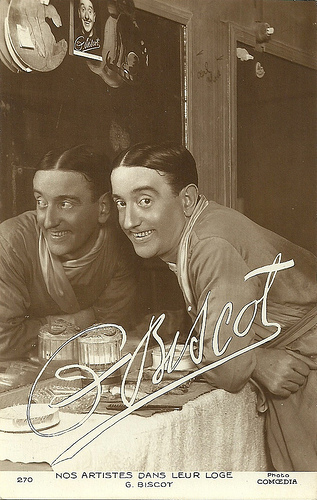
French postcard in the Series Nos Artistes dans leur loge by Editions La Fayette, no. 270. Photo: Comoedia.
A star of the Folies-Bergères
Georges Biscot was born Gaston Georges Bouzac in Courbevoie, near Paris, in 1886 (some sources say 1889). He studied at the Lycée Jean-Baptiste-Say in Paris and l’Ecole Estienne. Destined to become photogravure maker, he executed this profession for three years.
He then became projectionist at Pathé in Joinville near Paris. In 1904 he was hired by the Concert Bobino de Montparnasse where he gathered the functions of film projectionist and comedian for the theatrical programme.
In 1906 he launched himself in an artistic career in the Parisian cafés-concerts, singing La valse brune and Si mon cœur avait des roulettes, while moving on roller skates.
Georges Biscot debuted on the silver screen on 1913 in filmed songs, produced by Georges Lordier.
Soon he became a star of the music-hall of the Folies-Bergères, in particular when acting in La revue galante (1914) next to Musidora, then in À la parisienne (1916) where he did an imitation of Charles Chaplin .
In the same year he returned to film in the crime serial parody Le pied qui étreint/The clutching foot (Jacques Feyder, 1916). Impressed by his comic talent, Feyder recommended Biscot to Louis Feuillade.
Feuillade used him in Vendémiaire (Louis Feuillade, 1918) with René Cresté , and in the 7-hour mystery serial Tih Minh (Louis Feuillade, 1918) with Mary Harald. He succeeded Marcel Lévesque in the parts of jocular characters in the Feuillade films.
Subsequently, Biscot had notable comic parts in the serials Barrabas (Louis Feuillade, 1919) with Blanche Montel, Les deux gamines/The Two Girls (Louis Feuillade, 1921) with Sandra Milovanoff . With Milovanoff, he acted again in L’orpheline/The orphan (Louis Feuillade, 1921), Parisette (Louis Feuillade, 1921) and Le fils du filibustier/The son of the pirate (Louis Feuillade, 1922).
His final collaboration with Feuillade was with Vindicta/Vengeance (Louis Feuillade, 1923), a classic melodrama in which he played a simple guy, Césarin de Rétameur, who knows all but doesn’t talk.
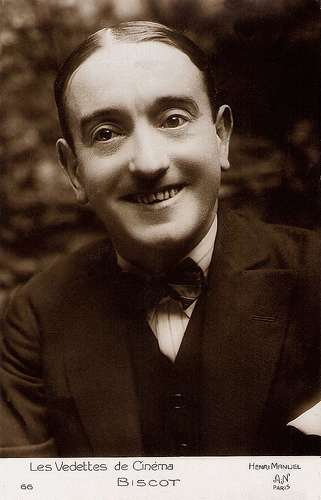
French postcard in the series Les Vedettes de Cinéma by A.N., Paris, no. 66. Photo: Henri Manuel.
A rugby man turned prankster
In the early 1920s at the Eldorado, Georges Biscot launched the revue Bibi-la-purée by Alexandre Fontanes and André Mouésy-Éon. The play was such a giant hit that quickly a film version was staged, Bibi-la-Purée (1925), directed by Maurice Champreux.
In the same year Biscot peaked as the amateur cyclist in Le roi de la pédale/The Pedlar (Maurice Champreux, 1925). In 1926, he was a rugby man turned prankster in Le p’tit parigot/The Small Parisian One (René Le Somptier, 1926).
Biscot returned to Champreux for his last silent film Les cinq sous de Lavarède/The Five Cents of Lavarede (Maurice Champreux, 1927), but also for his first sound film Hardi les gars!/Hardi guys! (Maurice Champreux, 1930) with Mona Goya in the female lead.
In the 1920s Biscot also created other chansons, such as La Môme Biclo (a song about the Tour de France with words by Cazalis and music by Dufas and Gardoni), Fernande (1922, words by Nazelles, music by Mauprey), Elle sait conduire une automobile, Cécile (1926, words by Nazelles, music by Chantrier), created for the revue La foire aux fiancés at the Théâtre du Châtelet, and the songs Emilienne - c’est y toi? and C’est pa.., pa…, c’est parisien, made for the film La bande à Bouboule/Bouboule's gang (Léon Mathot, 1931).

French postcard by Ed. Cinémagazine, no. 268. Photo: Film Gaumont. Publicity still for Le roi de la pédale (Maurice Champreux, 1925).
Georges Biscot sings Elle sait conduire une automobile. Source: Damien Chemillé (YouTube).
The most beautiful guy of France
During the 1930s, Georges Biscot remained a popular star of the Paris stage.
He played in only four films: Le clochard/Clochard (Robert Péguy, 1932), Six cent mille francs par mois/600,000 francs a month (Léo Joannon, 1933), a new adaptation of Bibi-la-purée (Léo Joannon 1934), and finally Le plus beau gosse de France/The most beautiful man in France (René Pujol, 1937) with Bernard Lancret in the title role, and also with Pauline Carton and Josseline Gaël .
During the Second World War, Biscot returned to the screen in major roles in three films: Un tel père et fils/The Heart of a Nation (Julien Duvivier, 1940) with Raimu , Michèle Morgan and Louis Jouvet , La cage aux rossignols/A Cage of Nightingales (Jean Dréville, 1943) with Noël-Noël, and La route du bagne/The road from prison (Léon Mathot, 1944) with Viviane Romance .
A few months after the release of these last two titles, Georges Biscot died in 1945 in Paris. He lies buried at the cemetery of Montrouge.
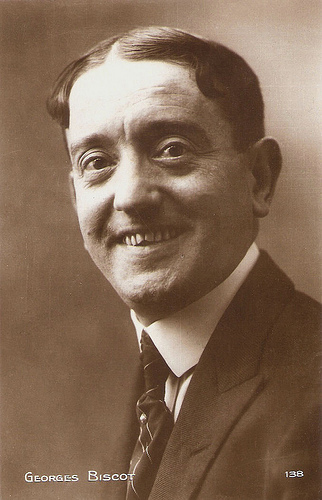
French postcard by Ed. Cinémagazine, no. 138.
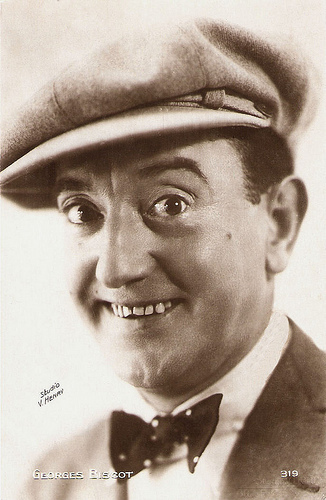
French postcard by Ed. Cinémagazine, No. 319. Photo Studio V. Henry.
Sources: Philippe Pelletier (CinéArtistes - French), Wikipedia (French and English), and .

French postcard in the Series Nos Artistes dans leur loge by Editions La Fayette, no. 270. Photo: Comoedia.
A star of the Folies-Bergères
Georges Biscot was born Gaston Georges Bouzac in Courbevoie, near Paris, in 1886 (some sources say 1889). He studied at the Lycée Jean-Baptiste-Say in Paris and l’Ecole Estienne. Destined to become photogravure maker, he executed this profession for three years.
He then became projectionist at Pathé in Joinville near Paris. In 1904 he was hired by the Concert Bobino de Montparnasse where he gathered the functions of film projectionist and comedian for the theatrical programme.
In 1906 he launched himself in an artistic career in the Parisian cafés-concerts, singing La valse brune and Si mon cœur avait des roulettes, while moving on roller skates.
Georges Biscot debuted on the silver screen on 1913 in filmed songs, produced by Georges Lordier.
Soon he became a star of the music-hall of the Folies-Bergères, in particular when acting in La revue galante (1914) next to Musidora, then in À la parisienne (1916) where he did an imitation of Charles Chaplin .
In the same year he returned to film in the crime serial parody Le pied qui étreint/The clutching foot (Jacques Feyder, 1916). Impressed by his comic talent, Feyder recommended Biscot to Louis Feuillade.
Feuillade used him in Vendémiaire (Louis Feuillade, 1918) with René Cresté , and in the 7-hour mystery serial Tih Minh (Louis Feuillade, 1918) with Mary Harald. He succeeded Marcel Lévesque in the parts of jocular characters in the Feuillade films.
Subsequently, Biscot had notable comic parts in the serials Barrabas (Louis Feuillade, 1919) with Blanche Montel, Les deux gamines/The Two Girls (Louis Feuillade, 1921) with Sandra Milovanoff . With Milovanoff, he acted again in L’orpheline/The orphan (Louis Feuillade, 1921), Parisette (Louis Feuillade, 1921) and Le fils du filibustier/The son of the pirate (Louis Feuillade, 1922).
His final collaboration with Feuillade was with Vindicta/Vengeance (Louis Feuillade, 1923), a classic melodrama in which he played a simple guy, Césarin de Rétameur, who knows all but doesn’t talk.

French postcard in the series Les Vedettes de Cinéma by A.N., Paris, no. 66. Photo: Henri Manuel.
A rugby man turned prankster
In the early 1920s at the Eldorado, Georges Biscot launched the revue Bibi-la-purée by Alexandre Fontanes and André Mouésy-Éon. The play was such a giant hit that quickly a film version was staged, Bibi-la-Purée (1925), directed by Maurice Champreux.
In the same year Biscot peaked as the amateur cyclist in Le roi de la pédale/The Pedlar (Maurice Champreux, 1925). In 1926, he was a rugby man turned prankster in Le p’tit parigot/The Small Parisian One (René Le Somptier, 1926).
Biscot returned to Champreux for his last silent film Les cinq sous de Lavarède/The Five Cents of Lavarede (Maurice Champreux, 1927), but also for his first sound film Hardi les gars!/Hardi guys! (Maurice Champreux, 1930) with Mona Goya in the female lead.
In the 1920s Biscot also created other chansons, such as La Môme Biclo (a song about the Tour de France with words by Cazalis and music by Dufas and Gardoni), Fernande (1922, words by Nazelles, music by Mauprey), Elle sait conduire une automobile, Cécile (1926, words by Nazelles, music by Chantrier), created for the revue La foire aux fiancés at the Théâtre du Châtelet, and the songs Emilienne - c’est y toi? and C’est pa.., pa…, c’est parisien, made for the film La bande à Bouboule/Bouboule's gang (Léon Mathot, 1931).

French postcard by Ed. Cinémagazine, no. 268. Photo: Film Gaumont. Publicity still for Le roi de la pédale (Maurice Champreux, 1925).
Georges Biscot sings Elle sait conduire une automobile. Source: Damien Chemillé (YouTube).
The most beautiful guy of France
During the 1930s, Georges Biscot remained a popular star of the Paris stage.
He played in only four films: Le clochard/Clochard (Robert Péguy, 1932), Six cent mille francs par mois/600,000 francs a month (Léo Joannon, 1933), a new adaptation of Bibi-la-purée (Léo Joannon 1934), and finally Le plus beau gosse de France/The most beautiful man in France (René Pujol, 1937) with Bernard Lancret in the title role, and also with Pauline Carton and Josseline Gaël .
During the Second World War, Biscot returned to the screen in major roles in three films: Un tel père et fils/The Heart of a Nation (Julien Duvivier, 1940) with Raimu , Michèle Morgan and Louis Jouvet , La cage aux rossignols/A Cage of Nightingales (Jean Dréville, 1943) with Noël-Noël, and La route du bagne/The road from prison (Léon Mathot, 1944) with Viviane Romance .
A few months after the release of these last two titles, Georges Biscot died in 1945 in Paris. He lies buried at the cemetery of Montrouge.

French postcard by Ed. Cinémagazine, no. 138.

French postcard by Ed. Cinémagazine, No. 319. Photo Studio V. Henry.
Sources: Philippe Pelletier (CinéArtistes - French), Wikipedia (French and English), and .
Published on March 02, 2015 22:00
March 1, 2015
Bransby Williams
British comic actor and writer Bransby Williams (1870-1961) was on stage from the 1890s and often worked as a monologist and impersonator. From 1911 on, he played roles in more than 20 films. He is best known for his portraying various Charles Dickens characters.
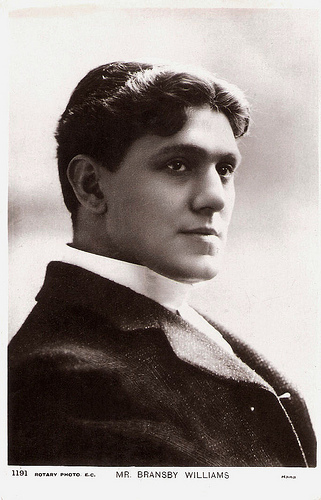
British postcard by Rotary Photo E.C., no. 1191. Photo: Hana.
A quick change artist
Bransby Williams was born Bransby William Pharez in London, England in 1870. His parents were William Meshech Pharez and Margaret Giles (née Booth).
He began his working life as a tea taster, clerk and designer of wallpapers. He appeared as an amateur actor before turning professional doing impersonations of Dan Leno , Gus Elen, and other music hall stars in working men's clubs.
His first appearance in a music hall was in 1896. In his music hall performances his specialism was as a quick change artist and mimic. He gave impersonations of the leading actors of that time, including Henry Irving in The Bells, Herbert Beerbohm Tree as Svengali from the popular play Trilby.
In 1897 Williams first created a variety of characters, including many from the works of Charles Dickens such as Uriah Heep, Bill Sikes and Fagin. In 1898 he appeared as Sydney Carton in The Noble Deed, based on A Tale of Two Cities at the Oxford Theatre.
Williams became a great success performing in monologues, recitations and sketches. A fine example of this is given in The Stage Door Keeper where Bransby uses the storyline to introduce a superb variety of artistes. In 1905 and 1907 he toured in the United States.
In 1911 he made his film debut in the short Royal England, a Story of an Empire's Throne (A.E. Coleby, Leo Stormont, 1911), a history of England's royalty, from Alfred the Great to Edward VII. In the following years he appeared in silent films like The Street Watchman's Story (Charles Vernon, 1914) and Bernardo's Confession (Charles Vernon, 1914).
He also played the lead opposite Ivy Close in Adam Bede (Maurice Elvey, 1918), based on a novel by George Eliot. Williams appeared in several adaptations of the novels by Charles Dickens, including The Adventures of Mr. Pickwick (Thomas Bentley, 1921) with Frederick Volpe as Samuel Pickwick. The film business was a side-line for Williams but his few silent films in the 1920s were very successful.
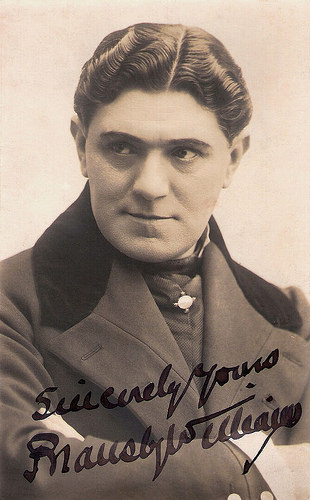
British postcard by Hana, London.
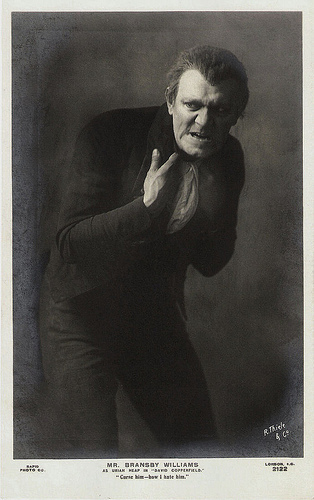
British postcard by Rapid Photo co., London, no. 3122 Photo: R. Thiele & Co.,. Publicity still for a stage production of David Copperfield. with Bransby Williams as Uriah Heep. Caption: "Curse him - how I hate him."
Blacklisted
Bransby Williams played Dickens’ Ebenezer Scrooge in the early sound film Scrooge (1928). This short film was the first talkie adaptation of any portion of A Christmas Carol, though it lasts only 9 minutes. It is now believed to be lost.
His impressive stage career came to an abrupt end in the early 1930s when he didn't keep to a five-year contract because of an accident of his wife. As a result he was blacklisted and hardly got work. Within no time he changed from one of the best paid actors to a man living near poverty.
In 1933, Williams had a supporting part in the musical comedy Soldiers of the King (Maurice Elvey, 1933) with Cicely Courtneidge and Edward Everett Horton. Williams played a horse and cart driver for the Local Authority in The Song of the Road (John Baxter, 1937).
During the war period, he was seen in the drama The Common Touch (John Baxter, 1941) with Greta Gynt, the comedy Those Kids from Town (Lance Comfort, 1942) and the war drama Tomorrow We Live (George King, 1943) with John Clements.
After the war, he returned as Ebenezer Scrooge in the TV film A Christmas Carol (1950). Later in his career Williams was a regular on radio and television. His final film role was in the crime drama Judgment Deferred (John Baxter, 1952).
Bransby Williams died in 1961 in London. Williams was married to Emilie Margaret Dent since 1892. He was survived by his daughters, Winnie, Ida and Betty, and by his son, the actor Eric Bransby Williams. His eldest son, Captain William George Bransby Williams, was killed during World War I. His body was never found.
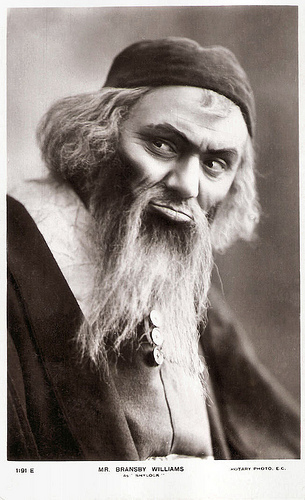
British postcard by Rotary Photo E.C., no. 1101 E. Photo: Bransby Williams as Shylock.
In his biography 'An actor's story', Bransby Williams described how he played Shylock, the character from William Shakespeare's The Merchant of Venice: "In Shylock I enter with the words, " There in Antonio I have another bad match," etc., and go through that speech to make it a complete sketch, and to get an exit I use sentences from other scenes. Thus, at the end of the above speech I speak, " And I tell thee — that if every ducat in six thousand ducats were in six parts and each part a ducat — I would have my bond — Antonio called me dog, before he had a cause — Well, as I am a dog, let him beware my fangs — I'll hear no more speaking — I'll have my bond — my bond, I swear ! " At this I make my exit, storming — so that I have used parts of other scenes to make a complete scene for presentation solus."
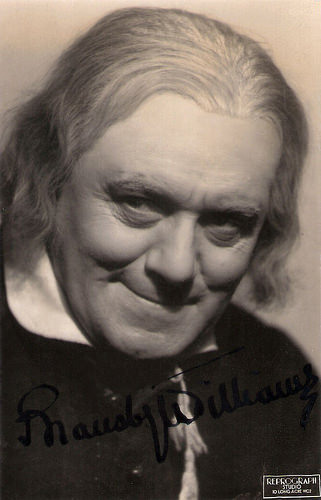
British postcard by Reprograph Studios, London.
Sources: Thomas Staedeli (Cyranos), Wikipedia, and .

British postcard by Rotary Photo E.C., no. 1191. Photo: Hana.
A quick change artist
Bransby Williams was born Bransby William Pharez in London, England in 1870. His parents were William Meshech Pharez and Margaret Giles (née Booth).
He began his working life as a tea taster, clerk and designer of wallpapers. He appeared as an amateur actor before turning professional doing impersonations of Dan Leno , Gus Elen, and other music hall stars in working men's clubs.
His first appearance in a music hall was in 1896. In his music hall performances his specialism was as a quick change artist and mimic. He gave impersonations of the leading actors of that time, including Henry Irving in The Bells, Herbert Beerbohm Tree as Svengali from the popular play Trilby.
In 1897 Williams first created a variety of characters, including many from the works of Charles Dickens such as Uriah Heep, Bill Sikes and Fagin. In 1898 he appeared as Sydney Carton in The Noble Deed, based on A Tale of Two Cities at the Oxford Theatre.
Williams became a great success performing in monologues, recitations and sketches. A fine example of this is given in The Stage Door Keeper where Bransby uses the storyline to introduce a superb variety of artistes. In 1905 and 1907 he toured in the United States.
In 1911 he made his film debut in the short Royal England, a Story of an Empire's Throne (A.E. Coleby, Leo Stormont, 1911), a history of England's royalty, from Alfred the Great to Edward VII. In the following years he appeared in silent films like The Street Watchman's Story (Charles Vernon, 1914) and Bernardo's Confession (Charles Vernon, 1914).
He also played the lead opposite Ivy Close in Adam Bede (Maurice Elvey, 1918), based on a novel by George Eliot. Williams appeared in several adaptations of the novels by Charles Dickens, including The Adventures of Mr. Pickwick (Thomas Bentley, 1921) with Frederick Volpe as Samuel Pickwick. The film business was a side-line for Williams but his few silent films in the 1920s were very successful.

British postcard by Hana, London.

British postcard by Rapid Photo co., London, no. 3122 Photo: R. Thiele & Co.,. Publicity still for a stage production of David Copperfield. with Bransby Williams as Uriah Heep. Caption: "Curse him - how I hate him."
Blacklisted
Bransby Williams played Dickens’ Ebenezer Scrooge in the early sound film Scrooge (1928). This short film was the first talkie adaptation of any portion of A Christmas Carol, though it lasts only 9 minutes. It is now believed to be lost.
His impressive stage career came to an abrupt end in the early 1930s when he didn't keep to a five-year contract because of an accident of his wife. As a result he was blacklisted and hardly got work. Within no time he changed from one of the best paid actors to a man living near poverty.
In 1933, Williams had a supporting part in the musical comedy Soldiers of the King (Maurice Elvey, 1933) with Cicely Courtneidge and Edward Everett Horton. Williams played a horse and cart driver for the Local Authority in The Song of the Road (John Baxter, 1937).
During the war period, he was seen in the drama The Common Touch (John Baxter, 1941) with Greta Gynt, the comedy Those Kids from Town (Lance Comfort, 1942) and the war drama Tomorrow We Live (George King, 1943) with John Clements.
After the war, he returned as Ebenezer Scrooge in the TV film A Christmas Carol (1950). Later in his career Williams was a regular on radio and television. His final film role was in the crime drama Judgment Deferred (John Baxter, 1952).
Bransby Williams died in 1961 in London. Williams was married to Emilie Margaret Dent since 1892. He was survived by his daughters, Winnie, Ida and Betty, and by his son, the actor Eric Bransby Williams. His eldest son, Captain William George Bransby Williams, was killed during World War I. His body was never found.

British postcard by Rotary Photo E.C., no. 1101 E. Photo: Bransby Williams as Shylock.
In his biography 'An actor's story', Bransby Williams described how he played Shylock, the character from William Shakespeare's The Merchant of Venice: "In Shylock I enter with the words, " There in Antonio I have another bad match," etc., and go through that speech to make it a complete sketch, and to get an exit I use sentences from other scenes. Thus, at the end of the above speech I speak, " And I tell thee — that if every ducat in six thousand ducats were in six parts and each part a ducat — I would have my bond — Antonio called me dog, before he had a cause — Well, as I am a dog, let him beware my fangs — I'll hear no more speaking — I'll have my bond — my bond, I swear ! " At this I make my exit, storming — so that I have used parts of other scenes to make a complete scene for presentation solus."

British postcard by Reprograph Studios, London.
Sources: Thomas Staedeli (Cyranos), Wikipedia, and .
Published on March 01, 2015 22:00
February 28, 2015
Mary Marquet
Mary Marquet (1895-1979) was a grande dame of the French stage, but she was also active as a screen actress. She appeared already in Sarah Bernhardt’s silent film La voyante (1923) and one of her final film roles was Donald Sutherland's mother in Fellini’s Casanova (1976).
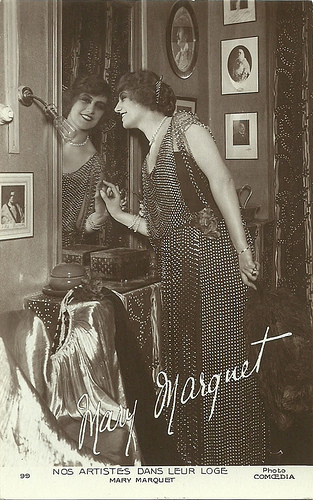
French postcard in the series Nos artistes dans leur loge by Ed. La Fayette, no. 99. Photo: Comoedia.
Stage struck
Micheline Marie Marguerite Delphine Marquet was the granddaughter of Delphine Marquet of the Comédie Française, niece of star dancer Louise Marquet, and daughter of stage actors Marcel Marquet and Louise Loisel.
She was born in 1895 in Saint-Petersburg, Russia, where her parents were under contract. In the early 20th century, the Marquets returned to live in Paris.
In 1909, the girl made her stage debut next to her parents under the name of Mary Marquet. The play was Anthony by Alexandre Dumas père.
In 1915 the young actress was hired by Sarah Bernhardt to act in her Paris theatre La tour de Nesles. She then acted in over 200 performances of L’aiglon by Edmond Rostand as the young Duke of Reichstadt. It was a triumph and Mary openly lived her affair with the great author.
In 1921 she divorced her first husband, stage actor Maurice Escande , in order to follow her new love Firmin Gémier at the Théâtre Antoine. From this meeting the creation of plays by Claude Farrère and Pierre Frandaie sprang up.
In 1923 Marquet entered the Comédie-Française and after five years, she became a Sociétaire. She was one of its most revered actresses for over twenty years. Mary also worked at the Théâtre Français.
While stage struck, Marquet was less active in film. In silent cinema she probably debuted in the short film Les frères ennemis/Enemy brothers (Henri Pouctal, 1913), a Le Film d'Art production.
This was followed by several other silent films such as Dalila (1916) with Jean Yonnel and Andrée Pascal, La ferme du Choquart/The Choquart farm (Jean Kemm, 1922) starring Geneviève Félix , and Sarah Bernhardt ’s last film La voyante/The Clairvoyant (Léon Abrams, Louis Mercanton, 1923).
In the 1930s, Marquet appeared only in Sapho/Sappho (Léonce Perret, 1933) and Les perles de la couronne/The Pearls of the Crown (Sacha Guitry, 1939) - and this despite a bright and tumultuous marriage with the famous film (and stage) actor Victor Francen .
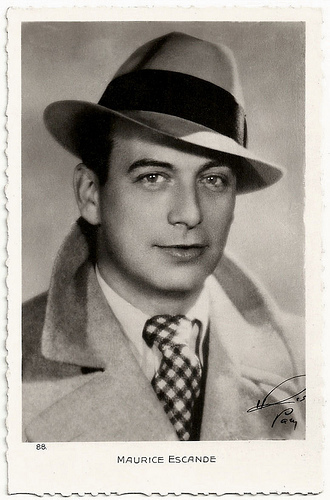
Maurice Escande . French postcard by Collection Chantal, Paris, no. 88.
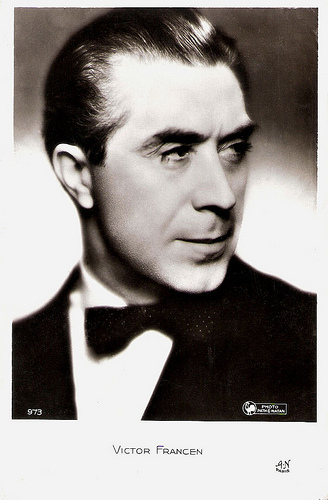
Victor Francen . French postcard by A.N., Paris, no. 973. Photo: Pathé Natan.
Casanova's Mother
During the Second World War, Mary Marquet continued to act on stage. She also gave 200 poetry recitals and like many other actors of the time, she participated in mundane manifestations under the Regime.
According to Philippe Pelletier at CinéArtistes , Marquet tried in 1943 to prevent that her son François, whom she had had with Firmin Gémier, was deported for working in the Resistance. It was in vain. François died in Buchenwald in January 1944.
Christophe Greseque at IMDb tells a different version: "During her trial, she admitted contacting the Vichy police in 1943 and asking them to prevent her son François from joining the Resistance. Despite a severe warning by the police, he still managed to flee to Spain but was arrested and deported to Buchenwald where he died in January 1944."
In 1944, Mary Marquet was arrested and sent to Fresne prison, near Paris: she was accused of collaborating with the Germans during the war as well as being instrumental to her son's arrest by the Gestapo. She was acquitted in January 1945 but was not allowed to return to the Comédie Française.
In 1946 she went back to the stage, but now of the boulevard theatre. (Light comedies are called 'comédies de boulevard' in French.) She also reappeared on screen for the comedies Interdit au public/Forbidden to the Public (Fred Pasquali, 1949) and Le quatre-vingt-quatre prend des vacances/The eighty-four takes a vacation (Léo Joannon, 1949) starring Rellys .
As a consequence, the tragedy actress turned into a comic actress, also in cinema. Her presence and height of 1.80 cm made her a remarkable actress in the next 25 years, acting in some 35 films.
Among her most striking parts were those of the Marquise de Maintenon in Si Versailles m’était conté/Royal Affairs in Versailles (1953) by Sacha Guitry, Queen Mother Elisabeth of Moldavia in Arsène Lupin contre Arsène Lupin/Arsene Lupin Contra Arsene Lupin (Edouard Molinaro, 1962), the Mother Superior in La grande vadrouille/The Big Runaround (Gérard Oury, 1966) with Louis de Funès and Bourvil and the old duchess in La merveilleuse visite/The Marvelous Visit (Marcel Carné, 1973).
Marquet also acted in drama and series on TV, such as in the title role of the TV film La visite de la vieille dame/The Visit of the Old Lady (Alberto Cavalcanti, 1971), based on the dark comedy by Friedrich Dürrenmatt.
One of her last roles was as Casanova's mother in the masterpiece Il Casanova di Federico Fellini/Casanova (Federico Fellini, 1976), starring Donald Sutherland as the famous Venetian libertine.
After a life of tragedy but also of spectacular successes, the Grand Old Lady of the French stage and screen died of a heart attack in 1979 in Paris (according to IMDb of the effects of a fall). She was 84. Mary Marquet lies buried at the cemetery of Montmartre.
Scene from Casanova (1976). Donald Sutherland's Casanova is reunited with his mother. Source: Fan 90042 (YouTube).
Sources: Philippe Pelletier (CinéArtistes), (IMDB), Wikipedia (French) and .

French postcard in the series Nos artistes dans leur loge by Ed. La Fayette, no. 99. Photo: Comoedia.
Stage struck
Micheline Marie Marguerite Delphine Marquet was the granddaughter of Delphine Marquet of the Comédie Française, niece of star dancer Louise Marquet, and daughter of stage actors Marcel Marquet and Louise Loisel.
She was born in 1895 in Saint-Petersburg, Russia, where her parents were under contract. In the early 20th century, the Marquets returned to live in Paris.
In 1909, the girl made her stage debut next to her parents under the name of Mary Marquet. The play was Anthony by Alexandre Dumas père.
In 1915 the young actress was hired by Sarah Bernhardt to act in her Paris theatre La tour de Nesles. She then acted in over 200 performances of L’aiglon by Edmond Rostand as the young Duke of Reichstadt. It was a triumph and Mary openly lived her affair with the great author.
In 1921 she divorced her first husband, stage actor Maurice Escande , in order to follow her new love Firmin Gémier at the Théâtre Antoine. From this meeting the creation of plays by Claude Farrère and Pierre Frandaie sprang up.
In 1923 Marquet entered the Comédie-Française and after five years, she became a Sociétaire. She was one of its most revered actresses for over twenty years. Mary also worked at the Théâtre Français.
While stage struck, Marquet was less active in film. In silent cinema she probably debuted in the short film Les frères ennemis/Enemy brothers (Henri Pouctal, 1913), a Le Film d'Art production.
This was followed by several other silent films such as Dalila (1916) with Jean Yonnel and Andrée Pascal, La ferme du Choquart/The Choquart farm (Jean Kemm, 1922) starring Geneviève Félix , and Sarah Bernhardt ’s last film La voyante/The Clairvoyant (Léon Abrams, Louis Mercanton, 1923).
In the 1930s, Marquet appeared only in Sapho/Sappho (Léonce Perret, 1933) and Les perles de la couronne/The Pearls of the Crown (Sacha Guitry, 1939) - and this despite a bright and tumultuous marriage with the famous film (and stage) actor Victor Francen .

Maurice Escande . French postcard by Collection Chantal, Paris, no. 88.

Victor Francen . French postcard by A.N., Paris, no. 973. Photo: Pathé Natan.
Casanova's Mother
During the Second World War, Mary Marquet continued to act on stage. She also gave 200 poetry recitals and like many other actors of the time, she participated in mundane manifestations under the Regime.
According to Philippe Pelletier at CinéArtistes , Marquet tried in 1943 to prevent that her son François, whom she had had with Firmin Gémier, was deported for working in the Resistance. It was in vain. François died in Buchenwald in January 1944.
Christophe Greseque at IMDb tells a different version: "During her trial, she admitted contacting the Vichy police in 1943 and asking them to prevent her son François from joining the Resistance. Despite a severe warning by the police, he still managed to flee to Spain but was arrested and deported to Buchenwald where he died in January 1944."
In 1944, Mary Marquet was arrested and sent to Fresne prison, near Paris: she was accused of collaborating with the Germans during the war as well as being instrumental to her son's arrest by the Gestapo. She was acquitted in January 1945 but was not allowed to return to the Comédie Française.
In 1946 she went back to the stage, but now of the boulevard theatre. (Light comedies are called 'comédies de boulevard' in French.) She also reappeared on screen for the comedies Interdit au public/Forbidden to the Public (Fred Pasquali, 1949) and Le quatre-vingt-quatre prend des vacances/The eighty-four takes a vacation (Léo Joannon, 1949) starring Rellys .
As a consequence, the tragedy actress turned into a comic actress, also in cinema. Her presence and height of 1.80 cm made her a remarkable actress in the next 25 years, acting in some 35 films.
Among her most striking parts were those of the Marquise de Maintenon in Si Versailles m’était conté/Royal Affairs in Versailles (1953) by Sacha Guitry, Queen Mother Elisabeth of Moldavia in Arsène Lupin contre Arsène Lupin/Arsene Lupin Contra Arsene Lupin (Edouard Molinaro, 1962), the Mother Superior in La grande vadrouille/The Big Runaround (Gérard Oury, 1966) with Louis de Funès and Bourvil and the old duchess in La merveilleuse visite/The Marvelous Visit (Marcel Carné, 1973).
Marquet also acted in drama and series on TV, such as in the title role of the TV film La visite de la vieille dame/The Visit of the Old Lady (Alberto Cavalcanti, 1971), based on the dark comedy by Friedrich Dürrenmatt.
One of her last roles was as Casanova's mother in the masterpiece Il Casanova di Federico Fellini/Casanova (Federico Fellini, 1976), starring Donald Sutherland as the famous Venetian libertine.
After a life of tragedy but also of spectacular successes, the Grand Old Lady of the French stage and screen died of a heart attack in 1979 in Paris (according to IMDb of the effects of a fall). She was 84. Mary Marquet lies buried at the cemetery of Montmartre.
Scene from Casanova (1976). Donald Sutherland's Casanova is reunited with his mother. Source: Fan 90042 (YouTube).
Sources: Philippe Pelletier (CinéArtistes), (IMDB), Wikipedia (French) and .
Published on February 28, 2015 22:00
February 27, 2015
Mädchen in Uniform (1931)
The German film Mädchen in Uniform/Girls in Uniform (Leontine Sagan, Carl Froelich, 1931) is a ground-breaking classic. The film made of its two lead actresses, Hertha Thiele and Dorothea Wieck, international stars - and lesbian idols.
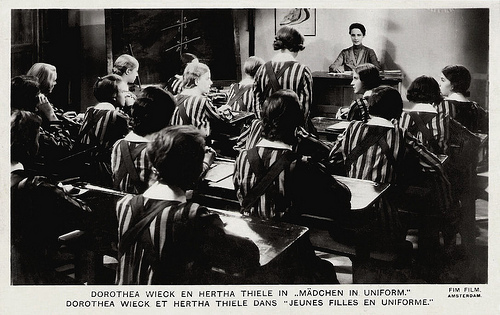
Dutch Postcard by M. Bonnist & Zonen, Amsterdam, Z., no. 104 e. Photo: Fim Film, Amsterdam. Publicity still for Mädchen in Uniform/Girls in Uniform (Leontine Sagan, Carl Froelich, 1931).
Spirited and independent
Manuela von Meinhardis ( Hertha Thiele ), a spirited and independent 14-year old schoolgirl, is sent to a boarding school for daughters of officers in Northern Germany, when her mother dies. The girls at this Catholic boarding school are slight, pale creatures - hungry for food and comfort.
The authoritarian head mistress, Fraülein von Nordeck zur Nidden (Emilia Unda), runs the school with an iron hand. She believes that daughters of Prussian soldiers must be taught discipline and deprivation, not luxury.
Ilse (Ellen Schwannecke) is the school trouble-maker, leader, and clown. Witty and outspoken, she repeatedly entertains the other girls, binding them together in secret comradery against their oppressive elders.
Like the rest of the girls, Manuela yearns for the attention of the fair and beautiful Elizabeth Von Bernburg ( Dorothea Wieck ), a young teacher who believes it's important to be the children's trusted friend. Manuela is ecstatic when Fraülein von Bernburg presents her with a gift, one of her slips, to replace the girl's own tattered underwear.
Relief from the regimentation of school life comes when the girls stage a theatrical production for students, staff and trustees of the boarding school. Manuela's performance as Don Carlos is accomplished and praised by students and staff.
At a party following the play, Manuela is the only student who can tolerate the taste of the punch given to them as a reward. Her friends pass their cups on to her and she soon gets herself quite drunk. In a semi-conscious state she announces her feelings for Fraulein von Burnberg to the entire school along with the infuriated Headmistress.
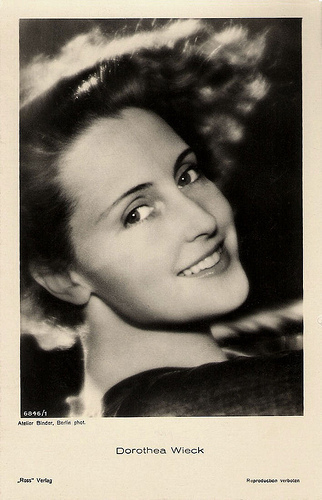
Dorothea Wieck . German postcard by Ross Verlag, no. 6846/1, 1931-1932. Photo: Atelier Binder, Berlin.
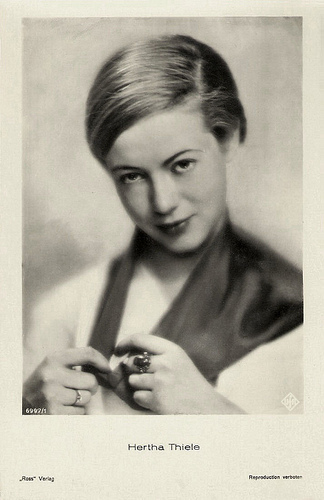
Hertha Thiele . German postcard by Ross Verlag, no. 6997/1, 1931-1932. Photo: Ufa.
At speed and on a low budget
German actress Hertha Thiele began her professional acting career in 1928 as a stage actress in Leipzig.
There she had her breakthrough two years later with the play Ritter Nérestan (Knight Nérestan) by Christa Winsloe.
Thiele and Claire Harden played the lead roles in this tale set in a Prussian boarding school for girls. The play, directed by Leontine Sagan, was an immediate success at its premiere in 1930.
After Leipzig the play was produced on stage in Berlin as Gestern und heute (Yesterday and Today), with a different cast and a more prominent lesbian theme. Again it was a huge success.
This success prompted Carl Froelich to adapt it for film. Reportedly he toned the lesbian theme somewhat down. He invited Leontine Sagan, for whom it was her first film. to join. The direction was split into direction of the cast and mise-en-scene by Sagan and overall direction by Carl Froelich, the Künstleriche Oberleitung.
After many screen tests, author Christa Winsloe insisted that Hertha Thiele played the lead role. Director Sagan preferred Gina Falckenberg who had done the role on stage in Berlin.
Thiele had already played a young lesbian in Ferdinand Bruckner's stage play Die Kreatur (The Creature) and although twenty-three years old when filming began, she was considered to be more capable of portraying a fourteen-year-old. The role of the adored teacher Fräulein von Bernburg was given to Swiss actress Dorothea Wieck .
Having mostly played the same roles on stage, the all-female cast was able to produce the film at speed and on a low budget of RM55,000. It was largely shot at the Potsdam military orphanage, now a teacher training college for women. Carl Froelich's studio in Berlin-Tempelhof was also used.
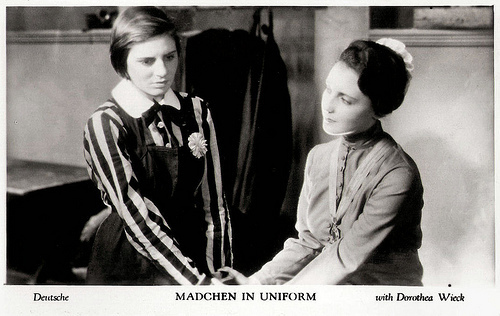
British card in the series Film Shots by Film Weekly. Photo: Deutsche. Publicity still for Mädchen in Uniform/Girls in Uniform (Leontine Sagan, Carl Froelich, 1931) with Ellen Schwannecke and Dorothea Wieck .
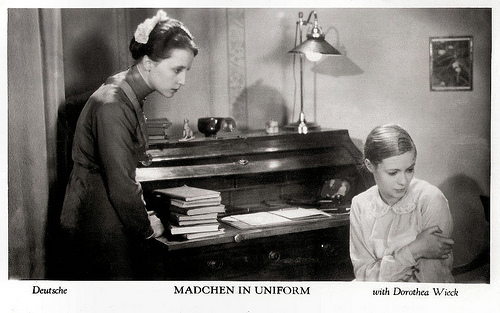
British card in the series Film Shots by Film Weekly. Photo: Deutsche. Publicity still for Mädchen in Uniform/Girls in Uniform (Leontine Sagan, Carl Froelich, 1931) with Dorothea Wieck and Hertha Thiele .
Goodnight kiss
From its premiere at the Capitol cinema in Berlin until 1934 Mädchen in Uniform grossed some RM 6,000,000. It was a success throughout much of Europe. The film won the audience referendum for Best Technical Perfection at the Venice Film Festival in 1932 and received the Japanese Kinema Junpo Award for Best Foreign Language Film in 1934.
The international success made of both Wieck and Thiele major stars. The goodnight kiss Thiele received from Wieck was especially popular: one distributor even asked for more footage of other kisses like it to splice into prints of the film.
Mädchen in Uniform was ground-breaking as one of the earliest narrative films to explicitly portray homosexuality. The two stars received thousands of fan letters, mostly from women, and both became lesbian idols. This made the film also very controversial.
Author Christa Winsloe was a lesbian. She was educated in the Empress Augusta boarding school, where Mädchen in Uniform was set. Reportedly there really was a Manuela, who remained lame all of her life after she threw herself down the stairs. She came to the premiere of the film and for Winsloe this experience was one she had to write from her heart.
Jan Onderwater at IMDb : "The play as well as the later novel emphasizes the sexual/lesbian love theme, but the film adaptation was toned down; the original sad end was replaced by a happy end. Though the film goes as far as it can in its theme of (awakening) lesbian feelings and sexual feelings of young girls in general, shifting emphasis automatically meant concentrating on the theme of the cold and inhumane authoritarian (Prussian) way of life and upbringing, a way of thinking still present in the Weimar republic and in 1931 already considered a danger to the young republic. Then audiences were more interested in this aspect than in the sexual one."
In the US, the film was first banned, but First Lady Eleanor Roosevelt saw the importance of it and the film got a limited American release in 1932-1933.
In Germany, an alternate ending which subtly pandered to pro-Nazi ideals enabled continued screening in German cinemas, but eventually even this version of the film was banned as 'decadent' by the Nazi regime, which reportedly attempted to burn all of the existing prints.
Leontine Sagan and many others associated with the film fled Germany soon after the banning. Many of the cast and crew were Jewish, including Emilia Unda and Ellen Schwannecke, and those who could not escape from Germany died in the camps. When assistant director Walter Supper realized his Jewish wife would be arrested, he shot her, himself and his dog.
Despite its later banning, Mädchen in Uniform was followed by several German films about intimate relationships among women, such as Acht Mädels im Boot/Eight Girls in a Boat (1932), Ich für dich, du für mich/Me for you, you for me (Carl Froelich, 1934) and Anna und Elisabeth/Anna and Elisabeth (Leontine Sagan, 1933), which also starred Wieck and Thiele but was banned by the Nazis soon after its opening night.
After the war, Mädchen in Uniform is said to have inspired the 1949 novel Olivia by Dorothy Bussy, which treats very similar themes, and which was made into the French film Olivia (Jacqueline Audry, 1951). And there was a German remake, Mädchen in Uniform, (Géza von Radványi, 1958) starring Lilli Palmer , Romy Schneider , and Therese Giehse.
The Nazis had attempted to burn all of the existing prints, but several had been dispersed around the world and survived the war. The screened film versions were heavily censored until the 1970s, and it was not shown again in Germany until 1977 when it was screened on television there. A year later, the film was re-released in the US. It's now an international cult classic, but according to Wikipedia even this and later released versions probably miss some brief scenes.
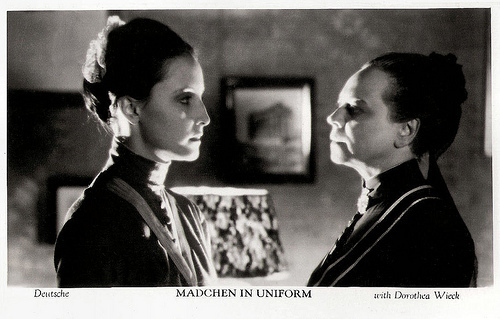
British card in the series Film Shots by Film Weekly. Photo: Deutsche. Publicity still for Mädchen in Uniform/Girls in Uniform (Leontine Sagan, Carl Froelich, 1931) with Dorothea Wieck and Emilia Unda.
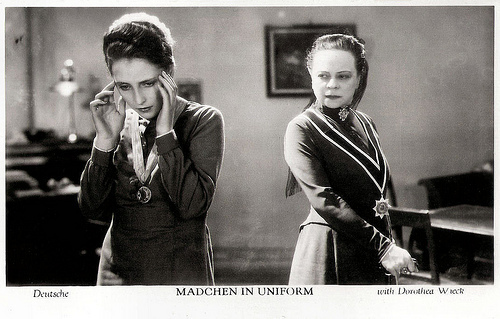
British card in the series Film Shots by Film Weekly. Photo: Deutsche. Publicity still for Mädchen in Uniform/Girls in Uniform (Leontine Sagan, Carl Froelich, 1931) with Dorothea Wieck and Emilia Unda.
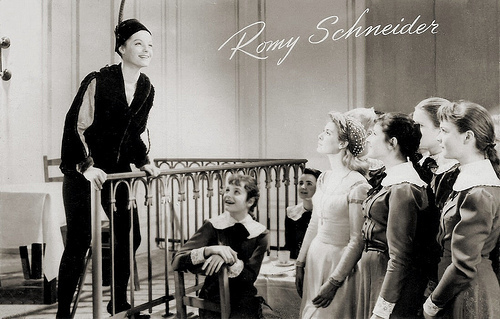
Dutch postcard by Takken, Utrecht (printed by 't Sticht), no. AX 3879, posted by mail in 1959. Photo: Grimm / C.C.C. / Gloria. Publicity still for Mädchen in Uniform/Girls in Uniform (Géza von Radványi, 1958) with Romy Schneider .
Sources: Heide Schlüpmann & Karola Gramman (Screening the past), Jan Onderwater (IMDb), Wikipedia and IMDb.

Dutch Postcard by M. Bonnist & Zonen, Amsterdam, Z., no. 104 e. Photo: Fim Film, Amsterdam. Publicity still for Mädchen in Uniform/Girls in Uniform (Leontine Sagan, Carl Froelich, 1931).
Spirited and independent
Manuela von Meinhardis ( Hertha Thiele ), a spirited and independent 14-year old schoolgirl, is sent to a boarding school for daughters of officers in Northern Germany, when her mother dies. The girls at this Catholic boarding school are slight, pale creatures - hungry for food and comfort.
The authoritarian head mistress, Fraülein von Nordeck zur Nidden (Emilia Unda), runs the school with an iron hand. She believes that daughters of Prussian soldiers must be taught discipline and deprivation, not luxury.
Ilse (Ellen Schwannecke) is the school trouble-maker, leader, and clown. Witty and outspoken, she repeatedly entertains the other girls, binding them together in secret comradery against their oppressive elders.
Like the rest of the girls, Manuela yearns for the attention of the fair and beautiful Elizabeth Von Bernburg ( Dorothea Wieck ), a young teacher who believes it's important to be the children's trusted friend. Manuela is ecstatic when Fraülein von Bernburg presents her with a gift, one of her slips, to replace the girl's own tattered underwear.
Relief from the regimentation of school life comes when the girls stage a theatrical production for students, staff and trustees of the boarding school. Manuela's performance as Don Carlos is accomplished and praised by students and staff.
At a party following the play, Manuela is the only student who can tolerate the taste of the punch given to them as a reward. Her friends pass their cups on to her and she soon gets herself quite drunk. In a semi-conscious state she announces her feelings for Fraulein von Burnberg to the entire school along with the infuriated Headmistress.

Dorothea Wieck . German postcard by Ross Verlag, no. 6846/1, 1931-1932. Photo: Atelier Binder, Berlin.

Hertha Thiele . German postcard by Ross Verlag, no. 6997/1, 1931-1932. Photo: Ufa.
At speed and on a low budget
German actress Hertha Thiele began her professional acting career in 1928 as a stage actress in Leipzig.
There she had her breakthrough two years later with the play Ritter Nérestan (Knight Nérestan) by Christa Winsloe.
Thiele and Claire Harden played the lead roles in this tale set in a Prussian boarding school for girls. The play, directed by Leontine Sagan, was an immediate success at its premiere in 1930.
After Leipzig the play was produced on stage in Berlin as Gestern und heute (Yesterday and Today), with a different cast and a more prominent lesbian theme. Again it was a huge success.
This success prompted Carl Froelich to adapt it for film. Reportedly he toned the lesbian theme somewhat down. He invited Leontine Sagan, for whom it was her first film. to join. The direction was split into direction of the cast and mise-en-scene by Sagan and overall direction by Carl Froelich, the Künstleriche Oberleitung.
After many screen tests, author Christa Winsloe insisted that Hertha Thiele played the lead role. Director Sagan preferred Gina Falckenberg who had done the role on stage in Berlin.
Thiele had already played a young lesbian in Ferdinand Bruckner's stage play Die Kreatur (The Creature) and although twenty-three years old when filming began, she was considered to be more capable of portraying a fourteen-year-old. The role of the adored teacher Fräulein von Bernburg was given to Swiss actress Dorothea Wieck .
Having mostly played the same roles on stage, the all-female cast was able to produce the film at speed and on a low budget of RM55,000. It was largely shot at the Potsdam military orphanage, now a teacher training college for women. Carl Froelich's studio in Berlin-Tempelhof was also used.

British card in the series Film Shots by Film Weekly. Photo: Deutsche. Publicity still for Mädchen in Uniform/Girls in Uniform (Leontine Sagan, Carl Froelich, 1931) with Ellen Schwannecke and Dorothea Wieck .

British card in the series Film Shots by Film Weekly. Photo: Deutsche. Publicity still for Mädchen in Uniform/Girls in Uniform (Leontine Sagan, Carl Froelich, 1931) with Dorothea Wieck and Hertha Thiele .
Goodnight kiss
From its premiere at the Capitol cinema in Berlin until 1934 Mädchen in Uniform grossed some RM 6,000,000. It was a success throughout much of Europe. The film won the audience referendum for Best Technical Perfection at the Venice Film Festival in 1932 and received the Japanese Kinema Junpo Award for Best Foreign Language Film in 1934.
The international success made of both Wieck and Thiele major stars. The goodnight kiss Thiele received from Wieck was especially popular: one distributor even asked for more footage of other kisses like it to splice into prints of the film.
Mädchen in Uniform was ground-breaking as one of the earliest narrative films to explicitly portray homosexuality. The two stars received thousands of fan letters, mostly from women, and both became lesbian idols. This made the film also very controversial.
Author Christa Winsloe was a lesbian. She was educated in the Empress Augusta boarding school, where Mädchen in Uniform was set. Reportedly there really was a Manuela, who remained lame all of her life after she threw herself down the stairs. She came to the premiere of the film and for Winsloe this experience was one she had to write from her heart.
Jan Onderwater at IMDb : "The play as well as the later novel emphasizes the sexual/lesbian love theme, but the film adaptation was toned down; the original sad end was replaced by a happy end. Though the film goes as far as it can in its theme of (awakening) lesbian feelings and sexual feelings of young girls in general, shifting emphasis automatically meant concentrating on the theme of the cold and inhumane authoritarian (Prussian) way of life and upbringing, a way of thinking still present in the Weimar republic and in 1931 already considered a danger to the young republic. Then audiences were more interested in this aspect than in the sexual one."
In the US, the film was first banned, but First Lady Eleanor Roosevelt saw the importance of it and the film got a limited American release in 1932-1933.
In Germany, an alternate ending which subtly pandered to pro-Nazi ideals enabled continued screening in German cinemas, but eventually even this version of the film was banned as 'decadent' by the Nazi regime, which reportedly attempted to burn all of the existing prints.
Leontine Sagan and many others associated with the film fled Germany soon after the banning. Many of the cast and crew were Jewish, including Emilia Unda and Ellen Schwannecke, and those who could not escape from Germany died in the camps. When assistant director Walter Supper realized his Jewish wife would be arrested, he shot her, himself and his dog.
Despite its later banning, Mädchen in Uniform was followed by several German films about intimate relationships among women, such as Acht Mädels im Boot/Eight Girls in a Boat (1932), Ich für dich, du für mich/Me for you, you for me (Carl Froelich, 1934) and Anna und Elisabeth/Anna and Elisabeth (Leontine Sagan, 1933), which also starred Wieck and Thiele but was banned by the Nazis soon after its opening night.
After the war, Mädchen in Uniform is said to have inspired the 1949 novel Olivia by Dorothy Bussy, which treats very similar themes, and which was made into the French film Olivia (Jacqueline Audry, 1951). And there was a German remake, Mädchen in Uniform, (Géza von Radványi, 1958) starring Lilli Palmer , Romy Schneider , and Therese Giehse.
The Nazis had attempted to burn all of the existing prints, but several had been dispersed around the world and survived the war. The screened film versions were heavily censored until the 1970s, and it was not shown again in Germany until 1977 when it was screened on television there. A year later, the film was re-released in the US. It's now an international cult classic, but according to Wikipedia even this and later released versions probably miss some brief scenes.

British card in the series Film Shots by Film Weekly. Photo: Deutsche. Publicity still for Mädchen in Uniform/Girls in Uniform (Leontine Sagan, Carl Froelich, 1931) with Dorothea Wieck and Emilia Unda.

British card in the series Film Shots by Film Weekly. Photo: Deutsche. Publicity still for Mädchen in Uniform/Girls in Uniform (Leontine Sagan, Carl Froelich, 1931) with Dorothea Wieck and Emilia Unda.

Dutch postcard by Takken, Utrecht (printed by 't Sticht), no. AX 3879, posted by mail in 1959. Photo: Grimm / C.C.C. / Gloria. Publicity still for Mädchen in Uniform/Girls in Uniform (Géza von Radványi, 1958) with Romy Schneider .
Sources: Heide Schlüpmann & Karola Gramman (Screening the past), Jan Onderwater (IMDb), Wikipedia and IMDb.
Published on February 27, 2015 22:00
February 26, 2015
Renate Ewert
Renate Ewert (1933-1966) was a German actress, who appeared in several European films and TV series of the 1950s and 1960s. Her suicide started a family tragedy.
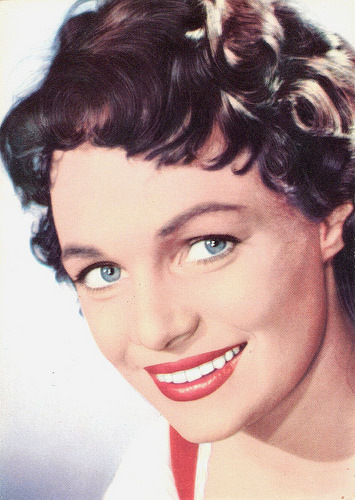
German postcard by ISV, no. M 10. Photo: Europa Film / Czerwonski.
Seductive, mysterious girl
Renate Ewert was born in Königsberg, Germany (now Kaliningrad, Russia), in 1933. Her father was a respected grain trader, her mother came from Poland. During the Second World War, mother and daughter fled Königsberg when the Russian front came closer. They settled in Hamburg. Her father followed, after spending four years as a prisoner of war.
Renate convinced her father not to let her finish school and instead went to acting classes by Ida Ehre. She applied for the Hamburger Kammerspiele but was rejected. She played in some roles on stage and did synchronizing jobs for foreign films.
When director Paul May was casting the role of Barbara Bruks in the third part of the successful series 08/15 – In der Heimat/08/15 - In the homeland (Paul May, 1954), he chose the then 20-year-old Ewert. The film series was based on Hans Hellmut Kirst's novel.
From then on, Ewert appeared in many post-war films as the seductive, mysterious girl but never got the dramatic parts she was eager to play. Ewert gained a reputation for lateness and for not always being too reliable on set. She also became fodder for the tabloids, when she had several affairs with such celebrities as actors Erik Schumann and Harald Juhnke, Wörthersee playboy Gerhard Berndt, and beverage dealer Hans-Hermann Weyer.
While filming the comedy Mikosch im Geheimdienst/Mikosch in Secret Service (Franz Marischka, Franz Josef Gottlieb, 1958), she started an affair with married producer Franz Marischka. He was 19 years her senior and the tabloids went wild. There were rumors she was the cause for Marischka’s divorce from his wife, Inge.
Later, she, Marischka, and Inge, now his ex, lived in the same apartment house in Munich-Schwabing, only two stories apart. She also had an affair with actor Paul Hubschmid while he was on the Vienna stage in My Fair Lady. Renate became the cause for a first suicide attempt by his wife, Ursula von Teubern. When Ursula Hubschmid eventually committed suicide, Renate felt guilty and started taking drugs.
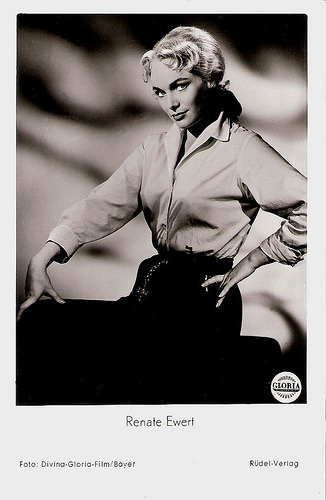
German postcard by Rüdel-Verlag, Hamburg-Bergedorf, no. 1499. Photo: Divina / Gloria / Bayer. Publicity still for 08/15 III. Teil/08/15 at Home (Paul May, 1955).
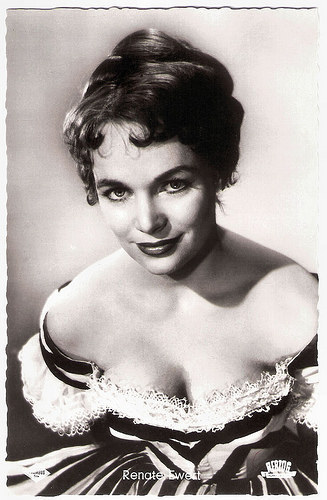
German postcard by Kolibri-Verlag, Minden/Westf., no. 2026. Photo: Rhombus / Herzog-Film / Czerwonski. Publicity still for Lumpazivagabundus (Franz Antel, 1956).
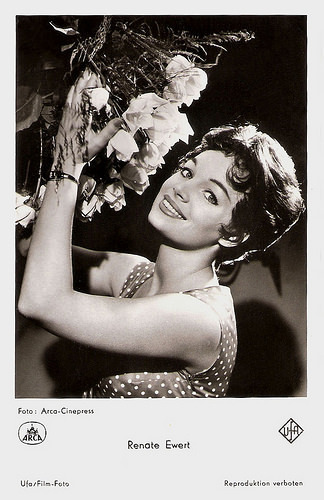
German postcard by Ufa, Berlin-Tempelhof, no. FK 4048. Photo: Arca / Cinepress. Publicity still for Liebe kann wie Gift sein/Love can be like poison (Veit Harlan, 1958).
Pills and alcohol
In 1960 Renate Ewert starred in the West German/Danish crime film Der rote Kreis/The Crimson Circle (Jürgen Roland, 1960). Scotland Yard detectives pursue a ruthless league of blackmailers known as The Crimson Circle. It was one of the many German Edgar Wallace adaptations of the 1960s, in this case of the 1922 novel The Crimson Circle. Der rote Kreis was the second film in the Wallace series produced by Rialto. The film's success encouraged the producers to meet with Penelope Wallace and secure the film rights for all available Wallace novels.
That same year, Renate also starred in Schlagerparade 1960 (Franz Marischka, 1960) and in the follow-up Schlagerparade 1961 (Franz Marischka, 1961). In France she made the films L'appartement des filles/Girl's Apartment (Michel Deville, 1963) with Mylène Demongeot , and Échappement libre/Backfire (Jean Becker, 1964) starring Jean-Paul Belmondo .
Another thriller was Hotel der toten Gäste/Hotel of the dead guests (Eberhard Itzenplitz, 1965) starring Joachim Fuchsberger , Karin Dor , and Elke Sommer . It was based on a novel by Heather Gardiner, an Australian mystery author who died in a car crash after just publishing two novels. In the film, which was shot in Bavaria, the police are called to a hotel, filled with visitors in town for a music festival, where one of the guests has been murdered.
Ewert also had a supporting part in Angélique, marquise des anges/Angélique (Bernard Borderie, 1964), the first part of the series of romantic costume films based on the popular novels by Anne and Serge Golon. Despite the success of this film, an international career did not establish.
On 10 December 1966, Renate Ewert was found dead on the floor of the bedroom of her apartment in Munich. She was found by actress Susanne Cramer , a friend who lived in the US and wanted to visit her. Ewert had died of pills and alcohol several days earlier, only 33. Dressed in a nightgown and weakened by pills, she starved to death and was nothing but skin and bones. In death her weight was only 34 kilos.
A month earlier her friend, Franz Marischka had left for Berlin, and shortly afterwards, her telephone service was cut because of non-payment. Distraught at the death of his daughter, her father Paul Ewert, who had insisted on an autopsy to determine the cause of death, took his life in 1967 with sleeping pills. In his suicide note he asked his wife to forgive him. His wife Helene poisoned herself in 1969.
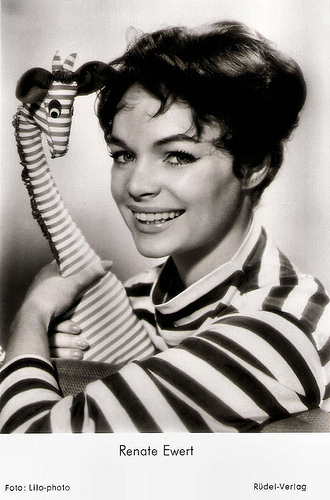
German postcard by Rüdel-Verlag, Hamburg-Bergedorf, no. 2633. Photo: Joe Lilo.
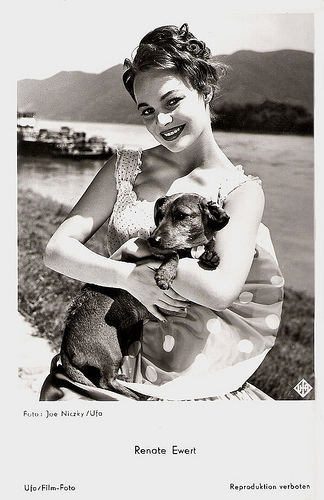
German postcard by Ufa, Berlin-Tempeldorf, no. FK 3113. Photo: Joe Niczky / Ufa.
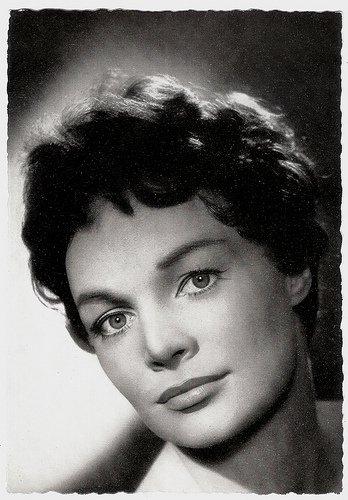
German postcard by WS-Druck, Wanne-Eickel, no. 300. Photo: Bavaria / Terrascope / Schorcht.
Sources: Holger Haase (Hallo, hier spricht...), (IMDb), Glamour Girls of the Silver Screen, Wikipedia (German and English) and .

German postcard by ISV, no. M 10. Photo: Europa Film / Czerwonski.
Seductive, mysterious girl
Renate Ewert was born in Königsberg, Germany (now Kaliningrad, Russia), in 1933. Her father was a respected grain trader, her mother came from Poland. During the Second World War, mother and daughter fled Königsberg when the Russian front came closer. They settled in Hamburg. Her father followed, after spending four years as a prisoner of war.
Renate convinced her father not to let her finish school and instead went to acting classes by Ida Ehre. She applied for the Hamburger Kammerspiele but was rejected. She played in some roles on stage and did synchronizing jobs for foreign films.
When director Paul May was casting the role of Barbara Bruks in the third part of the successful series 08/15 – In der Heimat/08/15 - In the homeland (Paul May, 1954), he chose the then 20-year-old Ewert. The film series was based on Hans Hellmut Kirst's novel.
From then on, Ewert appeared in many post-war films as the seductive, mysterious girl but never got the dramatic parts she was eager to play. Ewert gained a reputation for lateness and for not always being too reliable on set. She also became fodder for the tabloids, when she had several affairs with such celebrities as actors Erik Schumann and Harald Juhnke, Wörthersee playboy Gerhard Berndt, and beverage dealer Hans-Hermann Weyer.
While filming the comedy Mikosch im Geheimdienst/Mikosch in Secret Service (Franz Marischka, Franz Josef Gottlieb, 1958), she started an affair with married producer Franz Marischka. He was 19 years her senior and the tabloids went wild. There were rumors she was the cause for Marischka’s divorce from his wife, Inge.
Later, she, Marischka, and Inge, now his ex, lived in the same apartment house in Munich-Schwabing, only two stories apart. She also had an affair with actor Paul Hubschmid while he was on the Vienna stage in My Fair Lady. Renate became the cause for a first suicide attempt by his wife, Ursula von Teubern. When Ursula Hubschmid eventually committed suicide, Renate felt guilty and started taking drugs.

German postcard by Rüdel-Verlag, Hamburg-Bergedorf, no. 1499. Photo: Divina / Gloria / Bayer. Publicity still for 08/15 III. Teil/08/15 at Home (Paul May, 1955).

German postcard by Kolibri-Verlag, Minden/Westf., no. 2026. Photo: Rhombus / Herzog-Film / Czerwonski. Publicity still for Lumpazivagabundus (Franz Antel, 1956).

German postcard by Ufa, Berlin-Tempelhof, no. FK 4048. Photo: Arca / Cinepress. Publicity still for Liebe kann wie Gift sein/Love can be like poison (Veit Harlan, 1958).
Pills and alcohol
In 1960 Renate Ewert starred in the West German/Danish crime film Der rote Kreis/The Crimson Circle (Jürgen Roland, 1960). Scotland Yard detectives pursue a ruthless league of blackmailers known as The Crimson Circle. It was one of the many German Edgar Wallace adaptations of the 1960s, in this case of the 1922 novel The Crimson Circle. Der rote Kreis was the second film in the Wallace series produced by Rialto. The film's success encouraged the producers to meet with Penelope Wallace and secure the film rights for all available Wallace novels.
That same year, Renate also starred in Schlagerparade 1960 (Franz Marischka, 1960) and in the follow-up Schlagerparade 1961 (Franz Marischka, 1961). In France she made the films L'appartement des filles/Girl's Apartment (Michel Deville, 1963) with Mylène Demongeot , and Échappement libre/Backfire (Jean Becker, 1964) starring Jean-Paul Belmondo .
Another thriller was Hotel der toten Gäste/Hotel of the dead guests (Eberhard Itzenplitz, 1965) starring Joachim Fuchsberger , Karin Dor , and Elke Sommer . It was based on a novel by Heather Gardiner, an Australian mystery author who died in a car crash after just publishing two novels. In the film, which was shot in Bavaria, the police are called to a hotel, filled with visitors in town for a music festival, where one of the guests has been murdered.
Ewert also had a supporting part in Angélique, marquise des anges/Angélique (Bernard Borderie, 1964), the first part of the series of romantic costume films based on the popular novels by Anne and Serge Golon. Despite the success of this film, an international career did not establish.
On 10 December 1966, Renate Ewert was found dead on the floor of the bedroom of her apartment in Munich. She was found by actress Susanne Cramer , a friend who lived in the US and wanted to visit her. Ewert had died of pills and alcohol several days earlier, only 33. Dressed in a nightgown and weakened by pills, she starved to death and was nothing but skin and bones. In death her weight was only 34 kilos.
A month earlier her friend, Franz Marischka had left for Berlin, and shortly afterwards, her telephone service was cut because of non-payment. Distraught at the death of his daughter, her father Paul Ewert, who had insisted on an autopsy to determine the cause of death, took his life in 1967 with sleeping pills. In his suicide note he asked his wife to forgive him. His wife Helene poisoned herself in 1969.

German postcard by Rüdel-Verlag, Hamburg-Bergedorf, no. 2633. Photo: Joe Lilo.

German postcard by Ufa, Berlin-Tempeldorf, no. FK 3113. Photo: Joe Niczky / Ufa.

German postcard by WS-Druck, Wanne-Eickel, no. 300. Photo: Bavaria / Terrascope / Schorcht.
Sources: Holger Haase (Hallo, hier spricht...), (IMDb), Glamour Girls of the Silver Screen, Wikipedia (German and English) and .
Published on February 26, 2015 22:00
Paul van Yperen's Blog
- Paul van Yperen's profile
- 13 followers
Paul van Yperen isn't a Goodreads Author
(yet),
but they
do have a blog,
so here are some recent posts imported from
their feed.



